Attached files
| file | filename |
|---|---|
| 8-K - 8-K - Arcosa, Inc. | aca-20210309.htm |

Investor Presentation March 2021 Exhibit 99.1
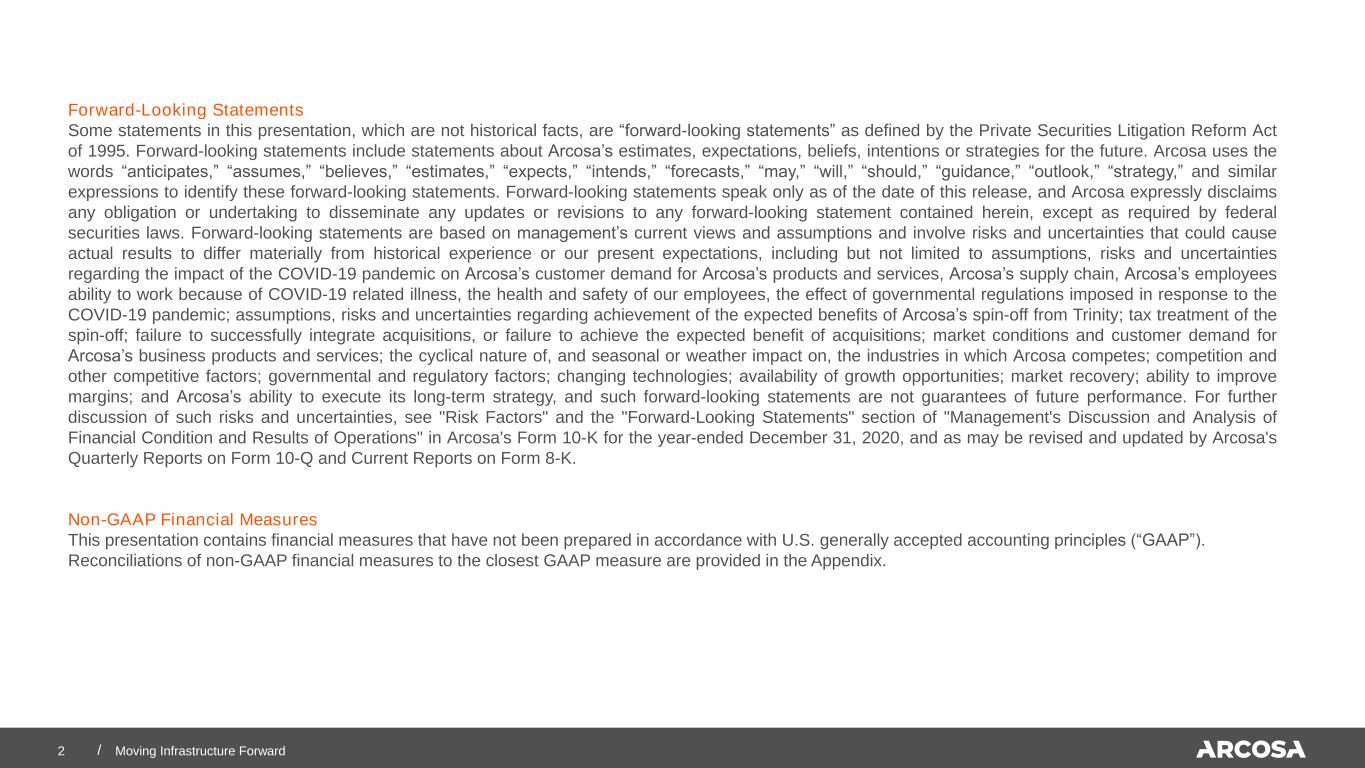
/ Moving Infrastructure Forward2 Forward-Looking Statements Some statements in this presentation, which are not historical facts, are “forward-looking statements” as defined by the Private Securities Litigation Reform Act of 1995. Forward-looking statements include statements about Arcosa’s estimates, expectations, beliefs, intentions or strategies for the future. Arcosa uses the words “anticipates,” “assumes,” “believes,” “estimates,” “expects,” “intends,” “forecasts,” “may,” “will,” “should,” “guidance,” “outlook,” “strategy,” and similar expressions to identify these forward-looking statements. Forward-looking statements speak only as of the date of this release, and Arcosa expressly disclaims any obligation or undertaking to disseminate any updates or revisions to any forward-looking statement contained herein, except as required by federal securities laws. Forward-looking statements are based on management’s current views and assumptions and involve risks and uncertainties that could cause actual results to differ materially from historical experience or our present expectations, including but not limited to assumptions, risks and uncertainties regarding the impact of the COVID-19 pandemic on Arcosa’s customer demand for Arcosa’s products and services, Arcosa’s supply chain, Arcosa’s employees ability to work because of COVID-19 related illness, the health and safety of our employees, the effect of governmental regulations imposed in response to the COVID-19 pandemic; assumptions, risks and uncertainties regarding achievement of the expected benefits of Arcosa’s spin-off from Trinity; tax treatment of the spin-off; failure to successfully integrate acquisitions, or failure to achieve the expected benefit of acquisitions; market conditions and customer demand for Arcosa’s business products and services; the cyclical nature of, and seasonal or weather impact on, the industries in which Arcosa competes; competition and other competitive factors; governmental and regulatory factors; changing technologies; availability of growth opportunities; market recovery; ability to improve margins; and Arcosa’s ability to execute its long-term strategy, and such forward-looking statements are not guarantees of future performance. For further discussion of such risks and uncertainties, see "Risk Factors" and the "Forward-Looking Statements" section of "Management's Discussion and Analysis of Financial Condition and Results of Operations" in Arcosa's Form 10-K for the year-ended December 31, 2020, and as may be revised and updated by Arcosa's Quarterly Reports on Form 10-Q and Current Reports on Form 8-K. Non-GAAP Financial Measures This presentation contains financial measures that have not been prepared in accordance with U.S. generally accepted accounting principles (“GAAP”). Reconciliations of non-GAAP financial measures to the closest GAAP measure are provided in the Appendix.
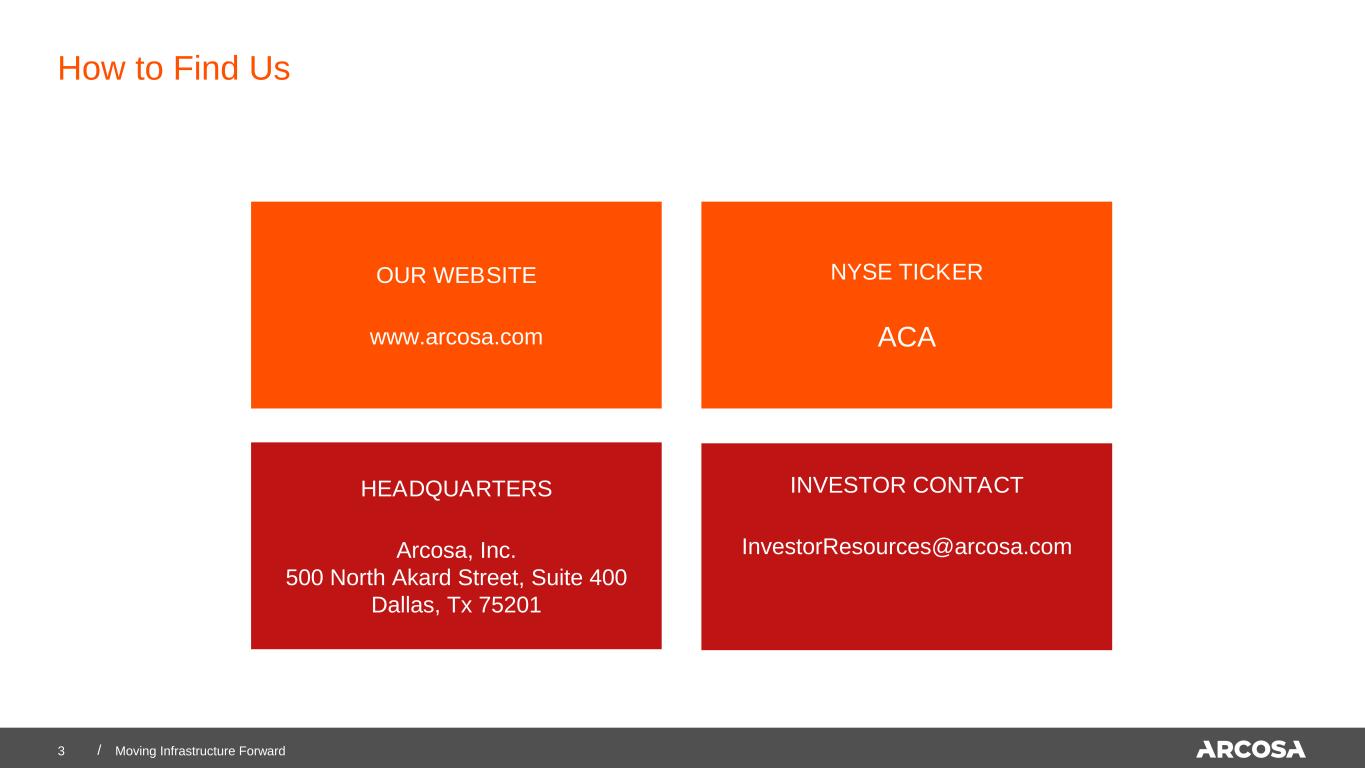
/ How to Find Us 3 INVESTOR CONTACT InvestorResources@arcosa.com NYSE TICKER ACA OUR WEBSITE www.arcosa.com HEADQUARTERS Arcosa, Inc. 500 North Akard Street, Suite 400 Dallas, Tx 75201 Moving Infrastructure Forward
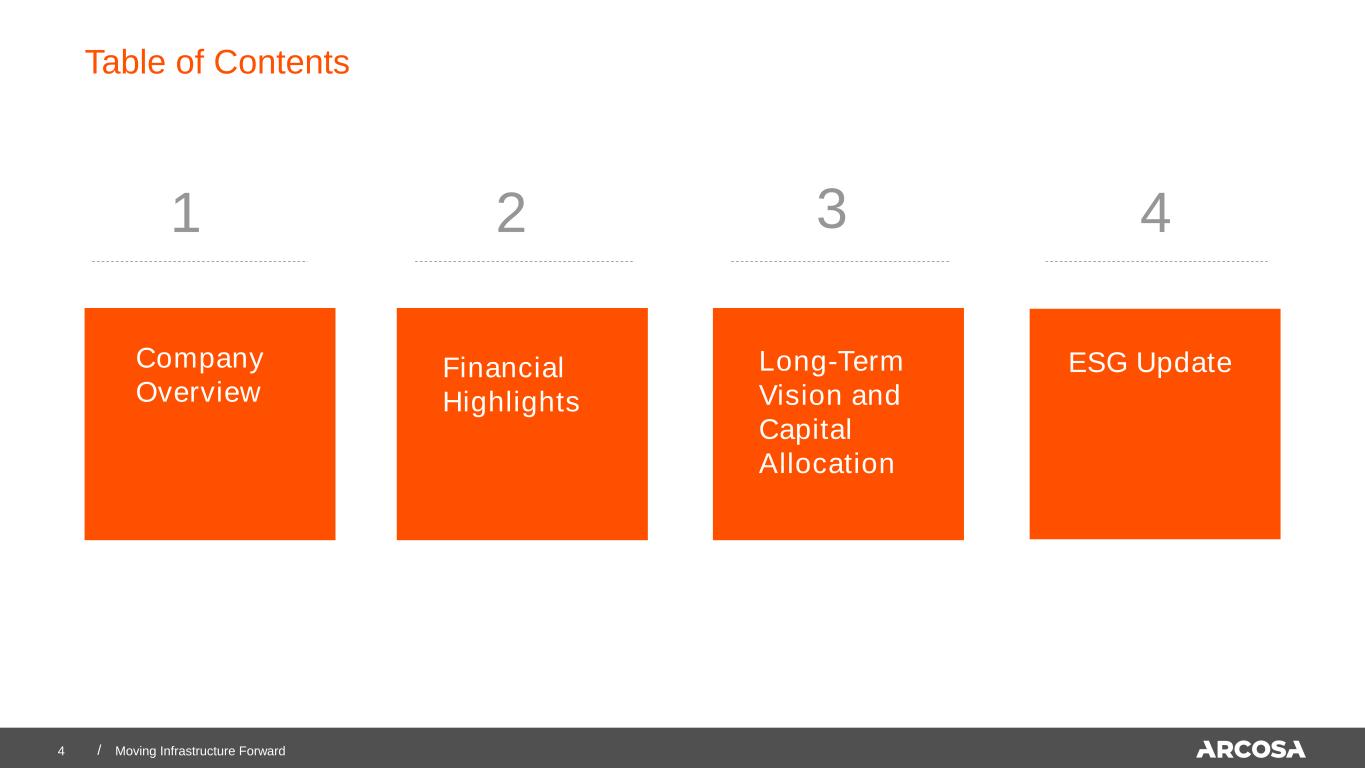
/4 1 3 4 Company Overview Long-Term Vision and Capital Allocation ESG Update Moving Infrastructure Forward 2 Financial Highlights Table of Contents
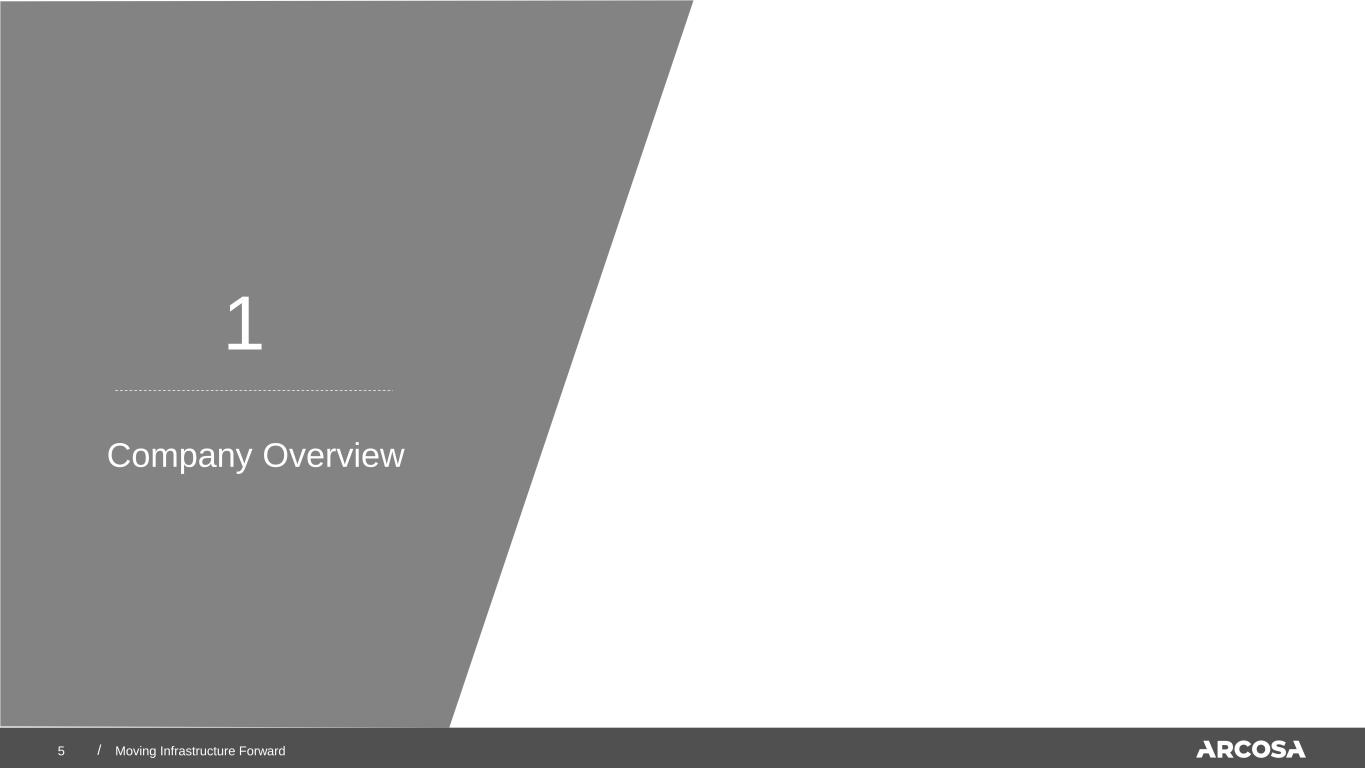
/5 1 Company Overview Moving Infrastructure Forward
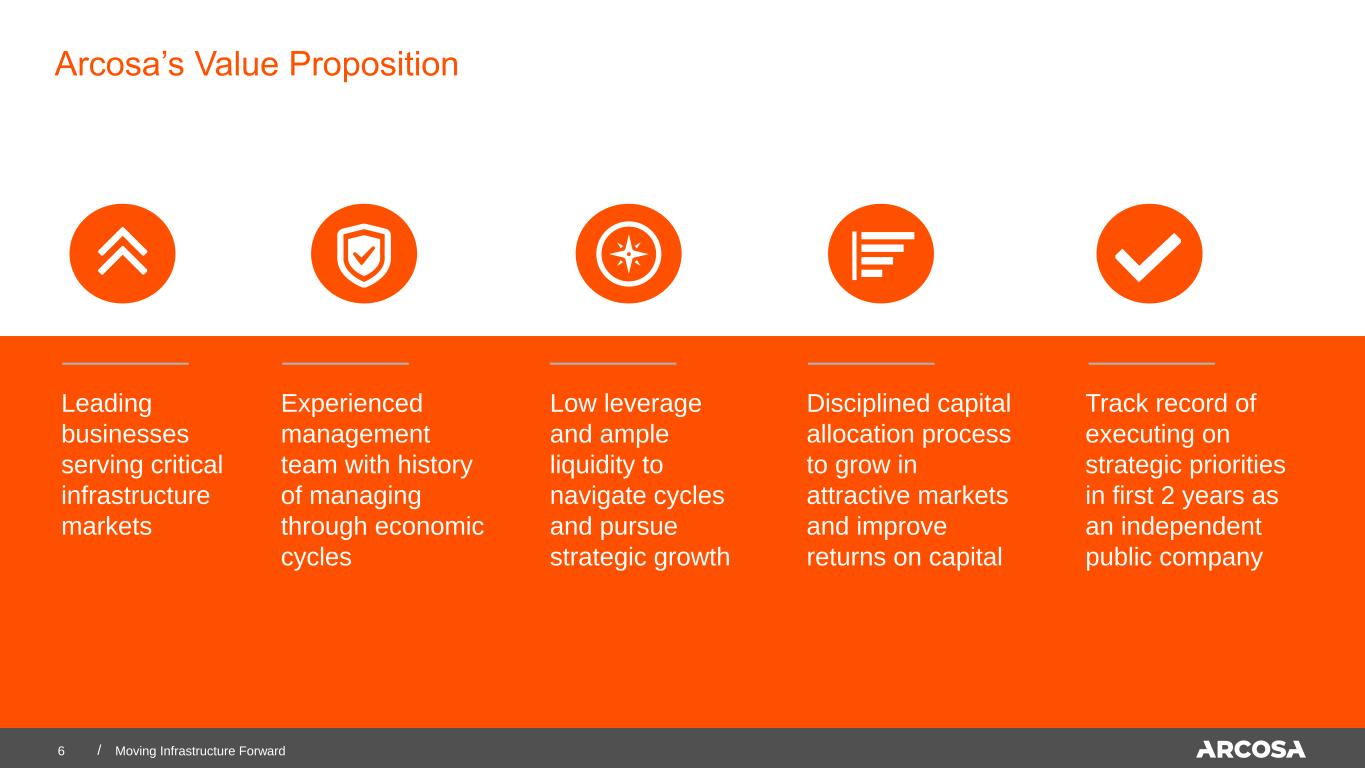
/6 Arcosa’s Value Proposition Low leverage and ample liquidity to navigate cycles and pursue strategic growth Experienced management team with history of managing through economic cycles Leading businesses serving critical infrastructure markets Track record of executing on strategic priorities in first 2 years as an independent public company Disciplined capital allocation process to grow in attractive markets and improve returns on capital Moving Infrastructure Forward
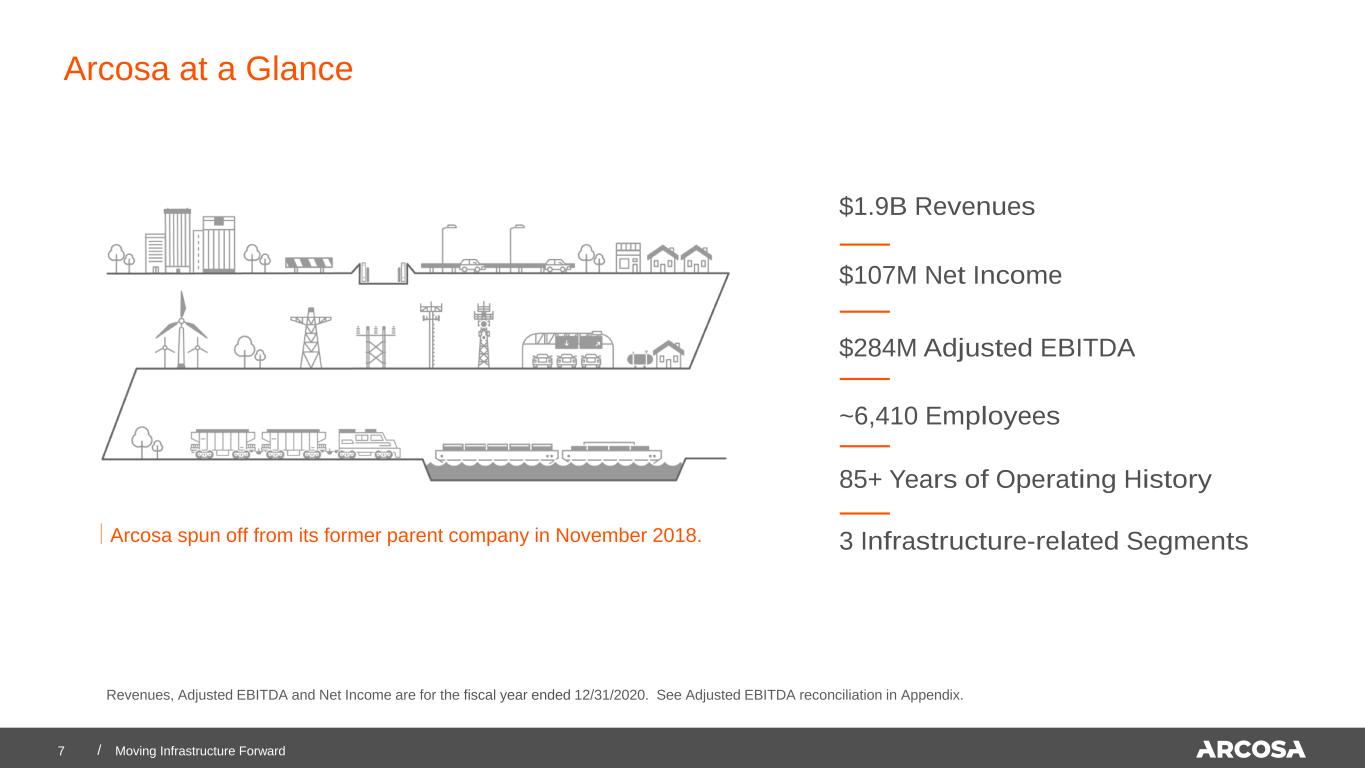
/7 Arcosa at a Glance Revenues, Adjusted EBITDA and Net Income are for the fiscal year ended 12/31/2020. See Adjusted EBITDA reconciliation in Appendix. Arcosa spun off from its former parent company in November 2018. $107M Net Income $284M Adjusted EBITDA $1.9B Revenues 3 Infrastructure-related Segments ~6,410 Employees 85+ Years of Operating History Moving Infrastructure Forward
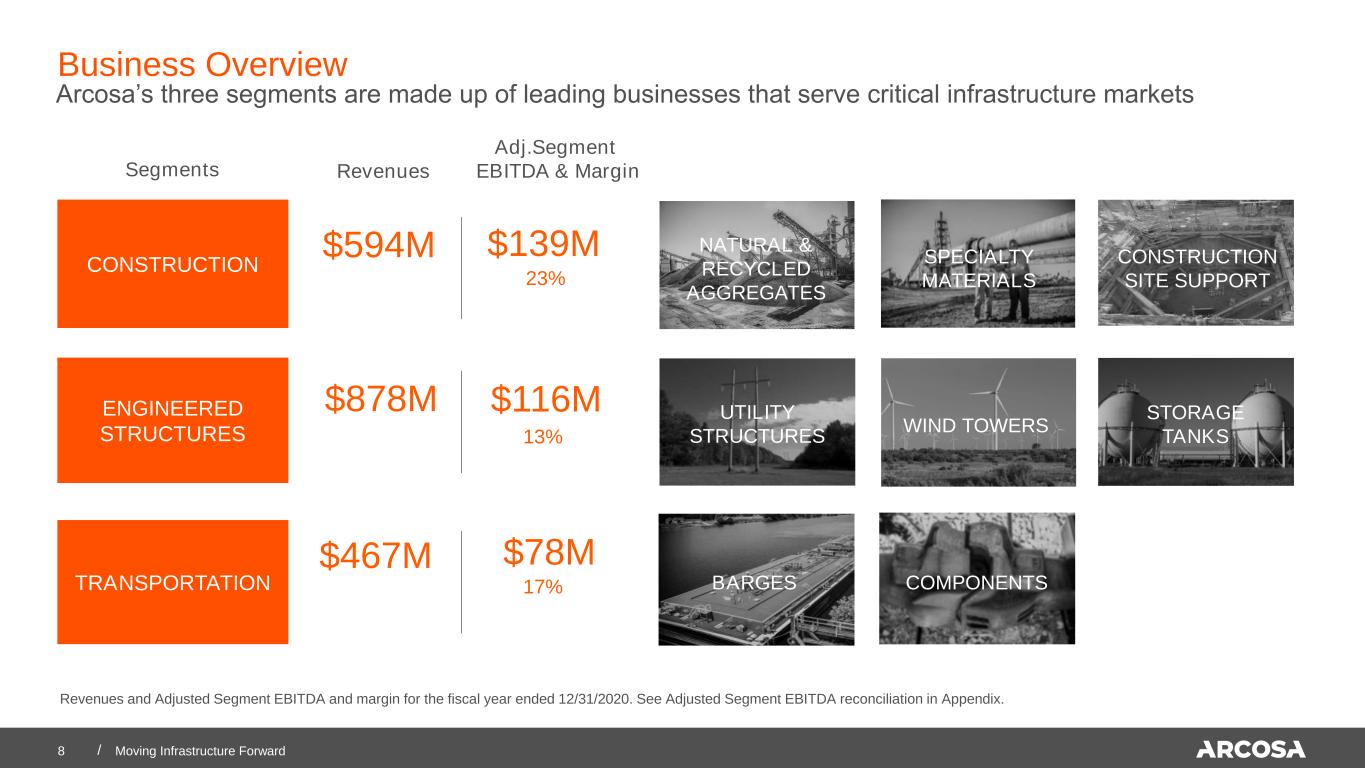
/ Business Overview 8 Revenues Revenues and Adjusted Segment EBITDA and margin for the fiscal year ended 12/31/2020. See Adjusted Segment EBITDA reconciliation in Appendix. ENGINEERED STRUCTURES TRANSPORTATION CONSTRUCTION Segments Adj.Segment EBITDA & Margin Arcosa’s three segments are made up of leading businesses that serve critical infrastructure markets NATURAL & RECYCLED AGGREGATES SPECIALTY MATERIALS CONSTRUCTION SITE SUPPORT WIND TOWERS UTILITY STRUCTURES STORAGE TANKS BARGES COMPONENTS Moving Infrastructure Forward $594M 23% $878M 13% $467M 17% $139M $116M $78M
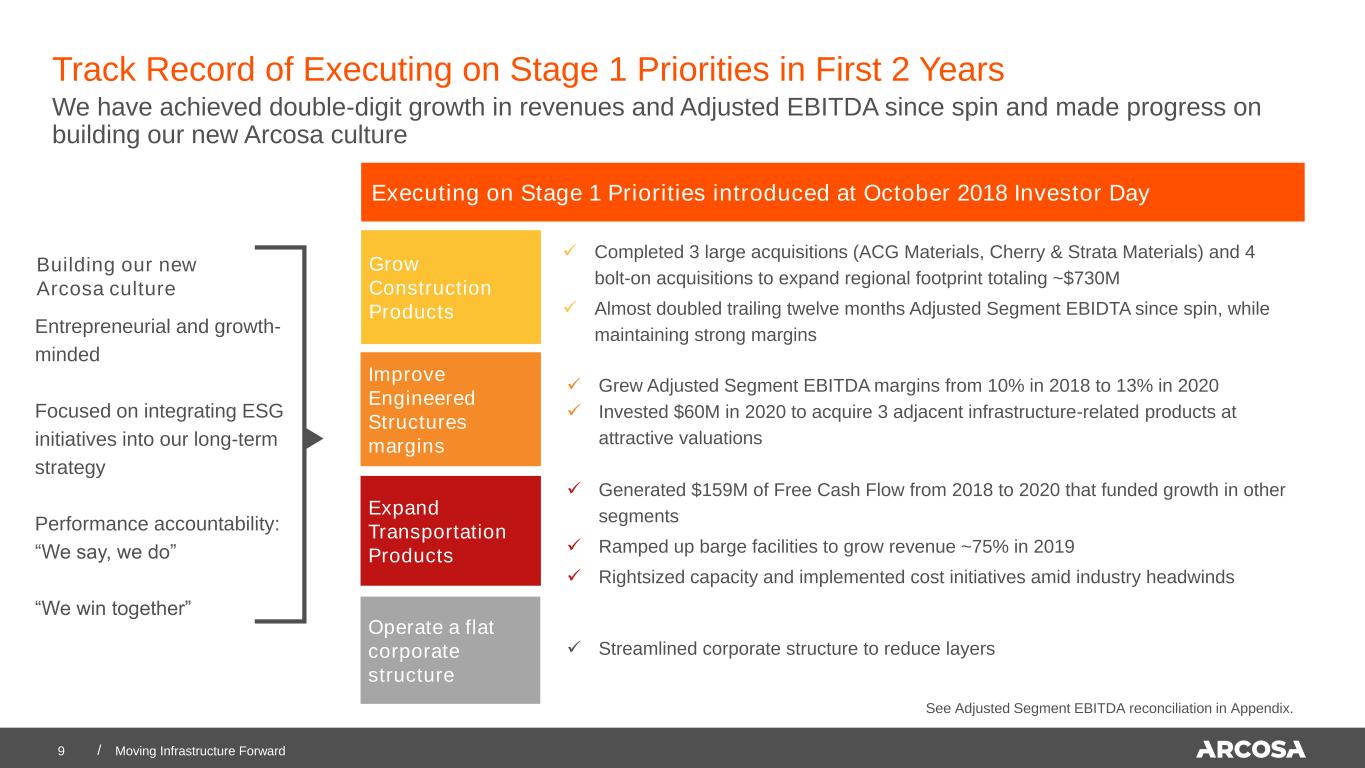
/9 Track Record of Executing on Stage 1 Priorities in First 2 Years Building our new Arcosa culture Executing on Stage 1 Priorities introduced at October 2018 Investor Day Grow Construction Products Improve Engineered Structures margins Expand Transportation Products Operate a flat corporate structure We have achieved double-digit growth in revenues and Adjusted EBITDA since spin and made progress on building our new Arcosa culture Entrepreneurial and growth- minded Focused on integrating ESG initiatives into our long-term strategy Performance accountability: “We say, we do” “We win together” See Adjusted Segment EBITDA reconciliation in Appendix. Moving Infrastructure Forward ✓ Completed 3 large acquisitions (ACG Materials, Cherry & Strata Materials) and 4 bolt-on acquisitions to expand regional footprint totaling ~$730M ✓ Almost doubled trailing twelve months Adjusted Segment EBIDTA since spin, while maintaining strong margins ✓ Grew Adjusted Segment EBITDA margins from 10% in 2018 to 13% in 2020 ✓ Invested $60M in 2020 to acquire 3 adjacent infrastructure-related products at attractive valuations ✓ Generated $159M of Free Cash Flow from 2018 to 2020 that funded growth in other segments ✓ Ramped up barge facilities to grow revenue ~75% in 2019 ✓ Rightsized capacity and implemented cost initiatives amid industry headwinds ✓ Streamlined corporate structure to reduce layers
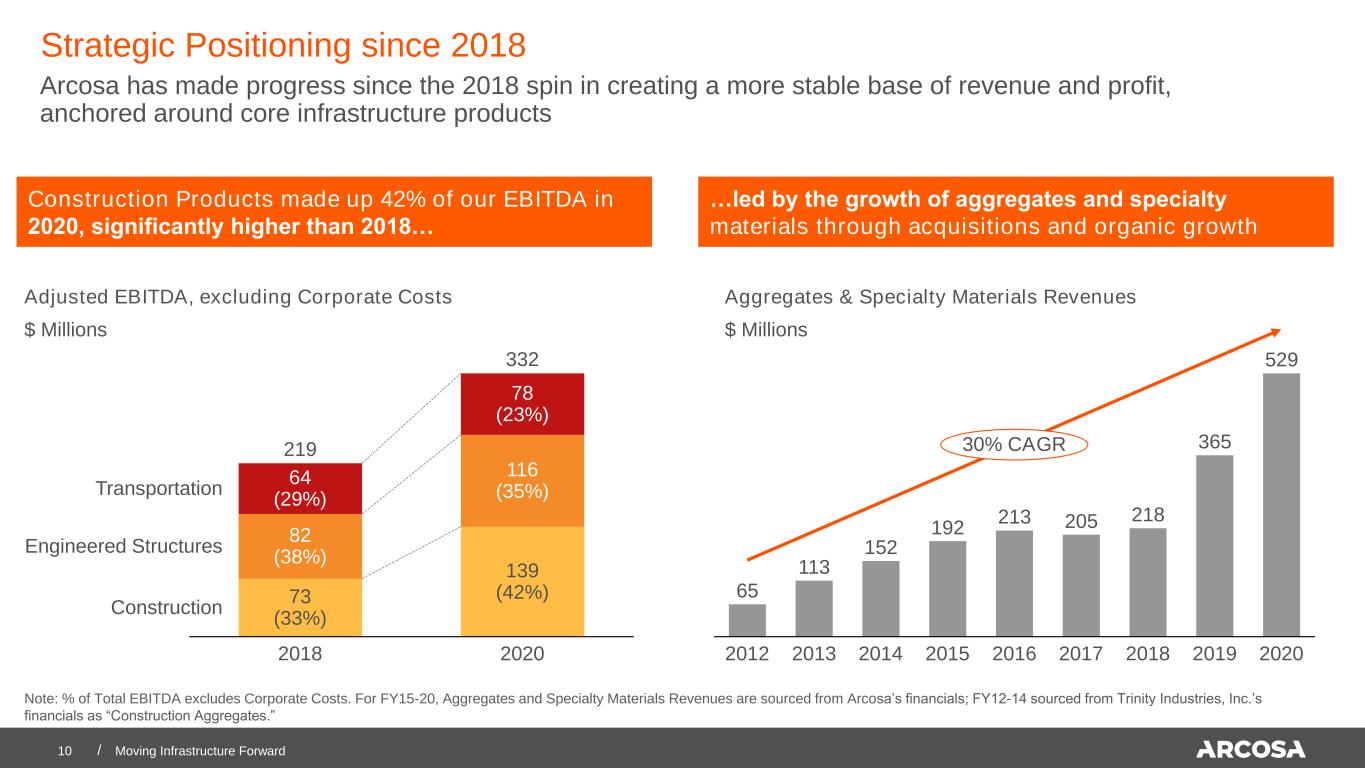
/10 Strategic Positioning since 2018 Arcosa has made progress since the 2018 spin in creating a more stable base of revenue and profit, anchored around core infrastructure products Moving Infrastructure Forward 65 113 152 192 213 205 218 365 529 2012 2013 201920172014 20162015 2018 2020 30% CAGR Aggregates & Specialty Materials Revenues $ Millions Note: % of Total EBITDA excludes Corporate Costs. For FY15-20, Aggregates and Specialty Materials Revenues are sourced from Arcosa’s financials; FY12-14 sourced from Trinity Industries, Inc.’s financials as “Construction Aggregates.” Construction Products made up 42% of our EBITDA in 2020, significantly higher than 2018… …led by the growth of aggregates and specialty materials through acquisitions and organic growth 78 (23%) Transportation 64 (29%) 73 (33%) 2020 332 82 (38%) 2018 116 (35%) 139 (42%) Construction Engineered Structures 219 Adjusted EBITDA, excluding Corporate Costs $ Millions

/11 2 Financial Highlights Moving Infrastructure Forward
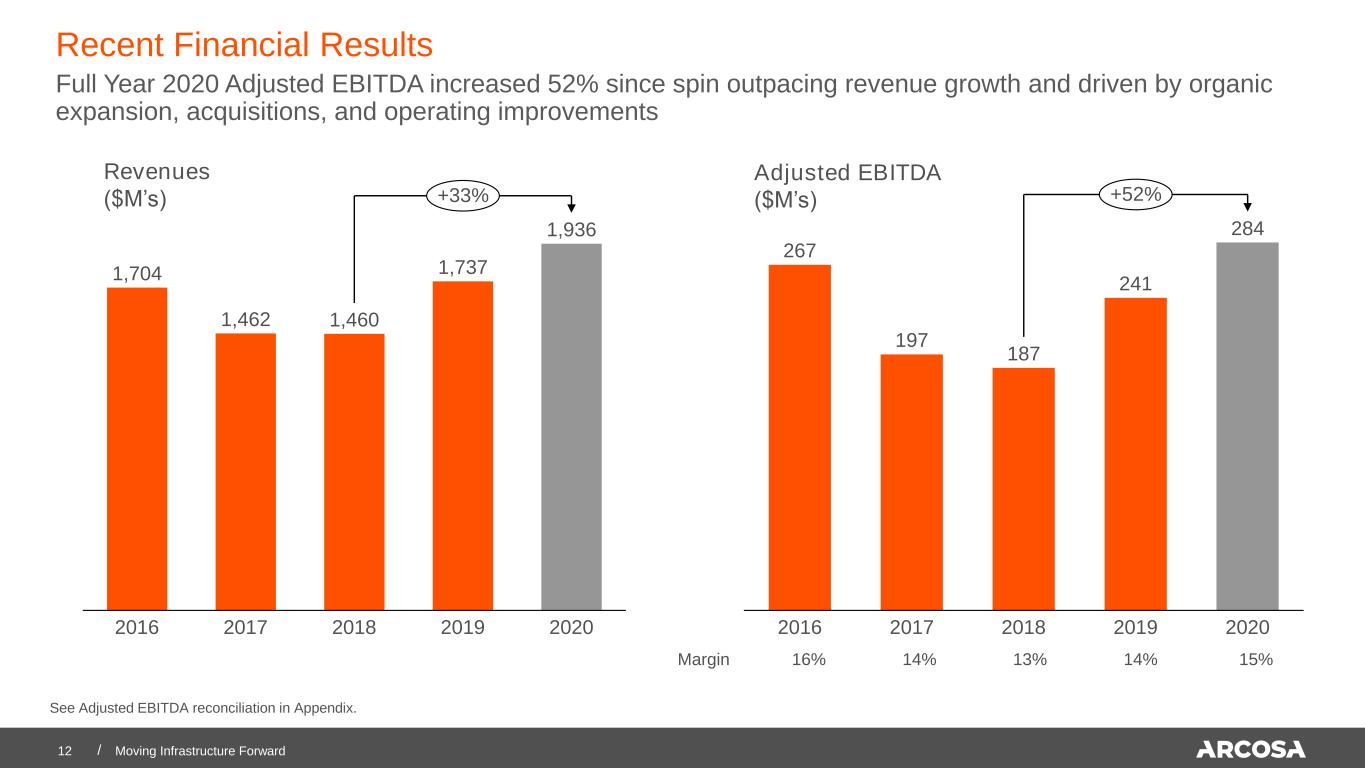
/12 1,704 1,462 1,460 1,737 1,936 2018 20192016 2017 2020 +33% Recent Financial Results Full Year 2020 Adjusted EBITDA increased 52% since spin outpacing revenue growth and driven by organic expansion, acquisitions, and operating improvements 267 197 187 241 284 2016 20192017 20202018 +52% See Adjusted EBITDA reconciliation in Appendix. Revenues ($M’s) Adjusted EBITDA ($M’s) Moving Infrastructure Forward Margin 16% 14% 13% 14% 15%

/ Cash Flow and Balance Sheet Strength Arcosa’s businesses have an attractive free cash flow profile, contributing to a strong balance sheet 13 Note: Free Cash Flow defined as GAAP Operating Cash Flow less GAAP capital expenditures. See reconciliation in Appendix Moving Infrastructure Forward Long-term target of 2-2.5x Outstanding Debt • $150M Floating rate borrowing at LIBOR+1.25% • $100M fixed rate revolver borrowing at ~4.0% Net Debt / Adjusted EBITDA Ratio at end of quarter Free Cash Flow $M’s 74 273 178 2018 2019 2020 % of Net Income 97% 241% 167% (1.2) 0.5 (0.6) 0.5 0.4 0.2 0.5 Pro Forma at Spin 4Q204Q18 3Q204Q19 1Q20 2Q20 Track record of de- leveraging post acquisition ... has supported significant organic & acquisition investment since spin, while maintaining a healthy balance sheet Focus on driving a disciplined ‘cash culture’….

/ COVID-19 Update We prioritize the health and safety of our people The health and safety of our employees, communities, and other stakeholders is our highest priority. We have put safeguard measures in place at our plants and office locations to meet or exceed the standards set forth by CDC guidelines. Protocols include: Social distancing processes in all facilities; measures to temperature screen employees daily; increased frequency of deep cleaning workspaces and common areas; reinforced hand washing and infection control training; processes to track and manage employees who report or have COVID-19 symptoms or exposure; actions to screen, limit or prohibit visitors to all facilities; and elimination of non- essential travel. Additionally, plant management and safety teams were able to quickly mobilize an operational response to COVID-19, implementing important tools created by collaborative leadership teams. From updates of CDC guidelines to best practice COVID-19 mitigation procedures, our teams have shown resilience and operational flexibility during times of uncertainty and change. We support critical infrastructure sectors Our businesses support critical infrastructure sectors, as defined by the Department of Homeland Security’s Cybersecurity and Infrastructure Security Agency (CISA.gov). These critical sectors are deemed essential to infrastructure, and our plants have continued operating to meet our customers’ needs. Moving Infrastructure Forward14 We build strong communities From supporting local restaurants, vendors, and small businesses, to donating funds for relevant non-profits, Arcosa has taken steps to enhance relationships and support our local communities. We have also shared our health and safety protocols with small businesses to improve practices in our communities.
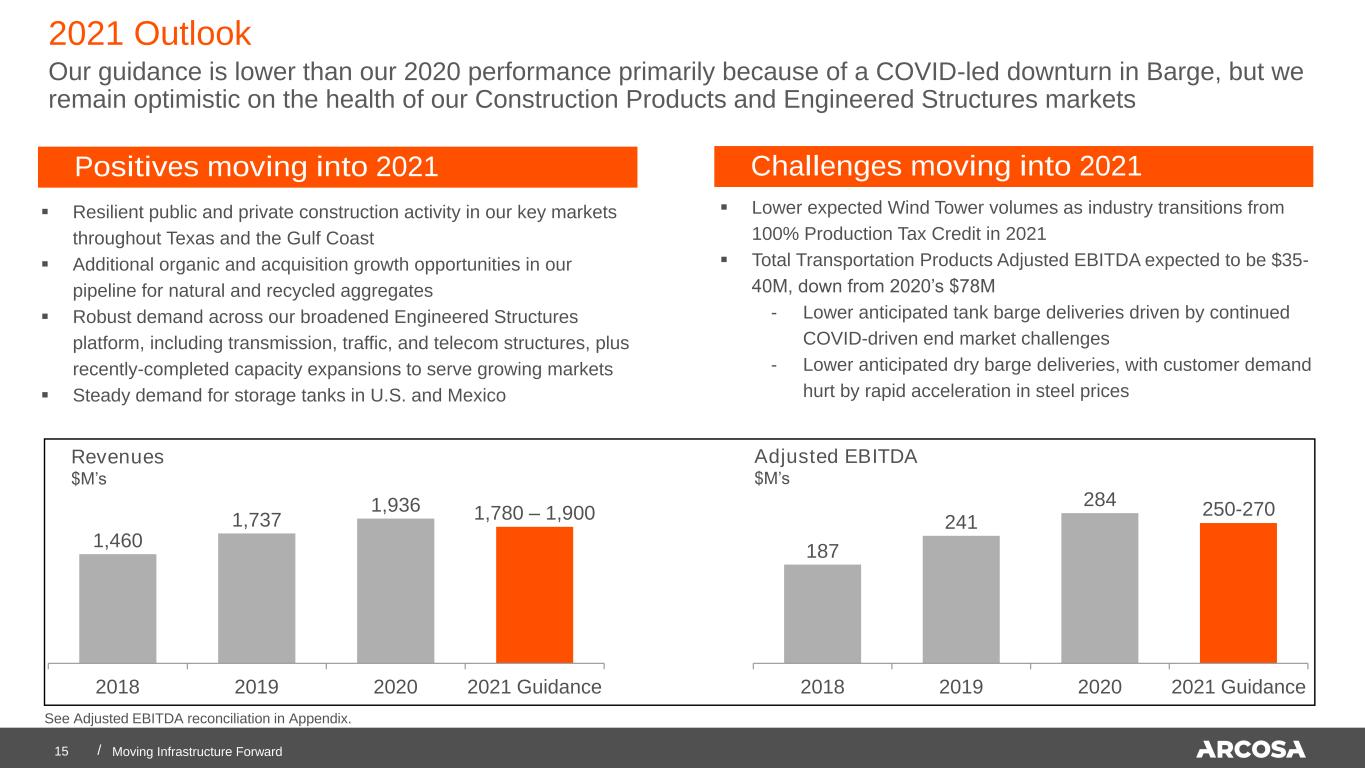
/ 2021 Outlook Our guidance is lower than our 2020 performance primarily because of a COVID-led downturn in Barge, but we remain optimistic on the health of our Construction Products and Engineered Structures markets Moving Infrastructure Forward15 See Adjusted EBITDA reconciliation in Appendix. Positives moving into 2021 Challenges moving into 2021 ▪ Resilient public and private construction activity in our key markets throughout Texas and the Gulf Coast ▪ Additional organic and acquisition growth opportunities in our pipeline for natural and recycled aggregates ▪ Robust demand across our broadened Engineered Structures platform, including transmission, traffic, and telecom structures, plus recently-completed capacity expansions to serve growing markets ▪ Steady demand for storage tanks in U.S. and Mexico Revenues $M’s Adjusted EBITDA $M’s ▪ Lower expected Wind Tower volumes as industry transitions from 100% Production Tax Credit in 2021 ▪ Total Transportation Products Adjusted EBITDA expected to be $35- 40M, down from 2020’s $78M - Lower anticipated tank barge deliveries driven by continued COVID-driven end market challenges - Lower anticipated dry barge deliveries, with customer demand hurt by rapid acceleration in steel prices 1,460 1,737 1,936 1,780 – 1,900 2018 2019 2020 2021 Guidance 187 241 284 20202018 2019 2021 Guidance 250-270
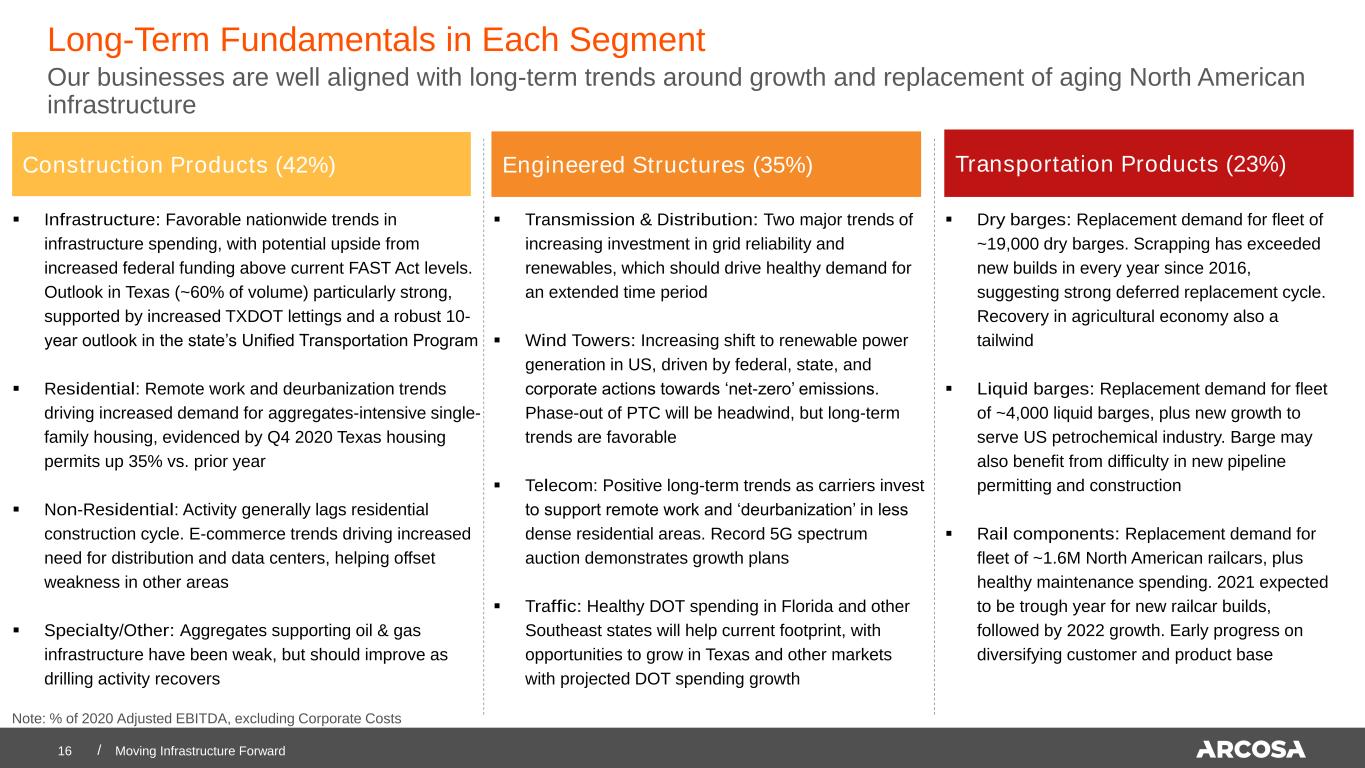
/16 Long-Term Fundamentals in Each Segment Moving Infrastructure Forward ▪ Infrastructure: Favorable nationwide trends in infrastructure spending, with potential upside from increased federal funding above current FAST Act levels. Outlook in Texas (~60% of volume) particularly strong, supported by increased TXDOT lettings and a robust 10- year outlook in the state’s Unified Transportation Program ▪ Residential: Remote work and deurbanization trends driving increased demand for aggregates-intensive single- family housing, evidenced by Q4 2020 Texas housing permits up 35% vs. prior year ▪ Non-Residential: Activity generally lags residential construction cycle. E-commerce trends driving increased need for distribution and data centers, helping offset weakness in other areas ▪ Specialty/Other: Aggregates supporting oil & gas infrastructure have been weak, but should improve as drilling activity recovers ▪ Transmission & Distribution: Two major trends of increasing investment in grid reliability and renewables, which should drive healthy demand for an extended time period ▪ Wind Towers: Increasing shift to renewable power generation in US, driven by federal, state, and corporate actions towards ‘net-zero’ emissions. Phase-out of PTC will be headwind, but long-term trends are favorable ▪ Telecom: Positive long-term trends as carriers invest to support remote work and ‘deurbanization’ in less dense residential areas. Record 5G spectrum auction demonstrates growth plans ▪ Traffic: Healthy DOT spending in Florida and other Southeast states will help current footprint, with opportunities to grow in Texas and other markets with projected DOT spending growth ▪ Dry barges: Replacement demand for fleet of ~19,000 dry barges. Scrapping has exceeded new builds in every year since 2016, suggesting strong deferred replacement cycle. Recovery in agricultural economy also a tailwind ▪ Liquid barges: Replacement demand for fleet of ~4,000 liquid barges, plus new growth to serve US petrochemical industry. Barge may also benefit from difficulty in new pipeline permitting and construction ▪ Rail components: Replacement demand for fleet of ~1.6M North American railcars, plus healthy maintenance spending. 2021 expected to be trough year for new railcar builds, followed by 2022 growth. Early progress on diversifying customer and product base Our businesses are well aligned with long-term trends around growth and replacement of aging North American infrastructure Note: % of 2020 Adjusted EBITDA, excluding Corporate Costs Construction Products (42%) Engineered Structures (35%) Transportation Products (23%)
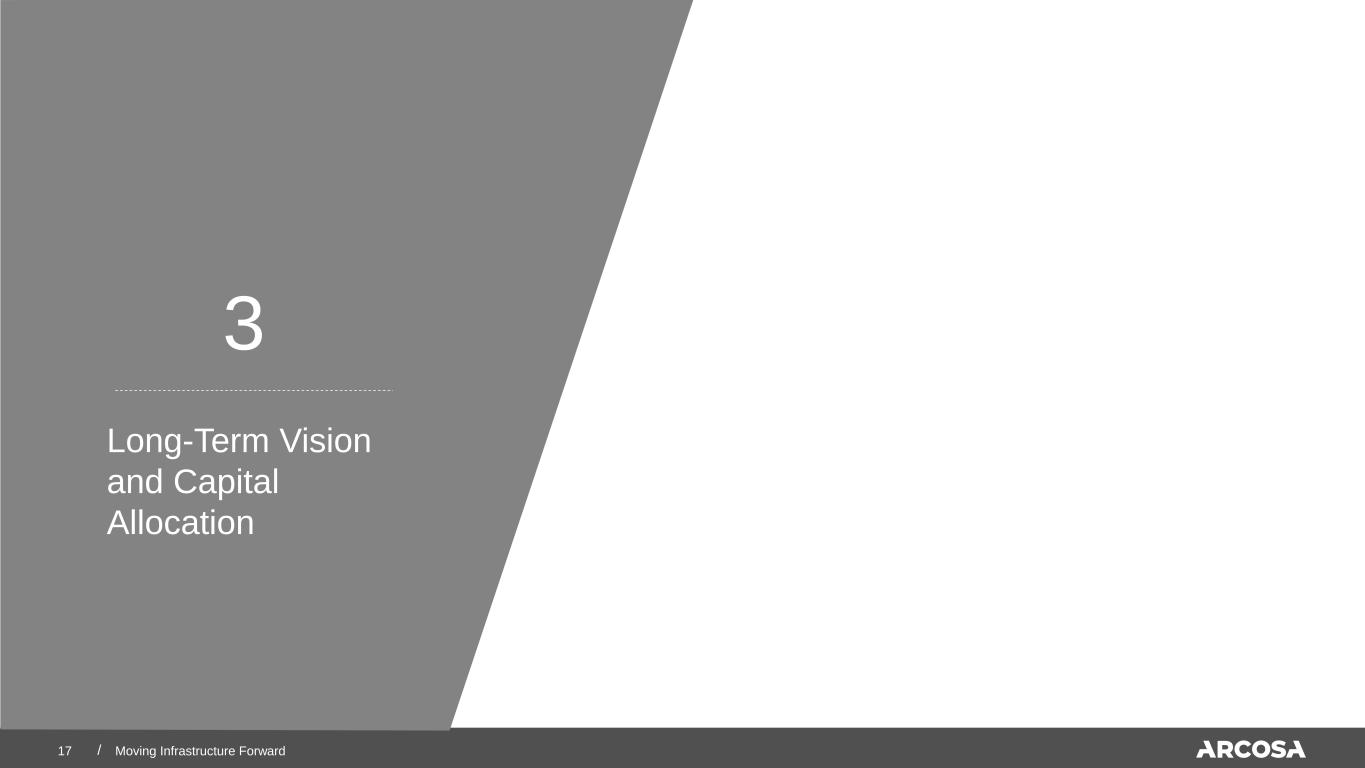
/17 3 Long-Term Vision and Capital Allocation Moving Infrastructure Forward
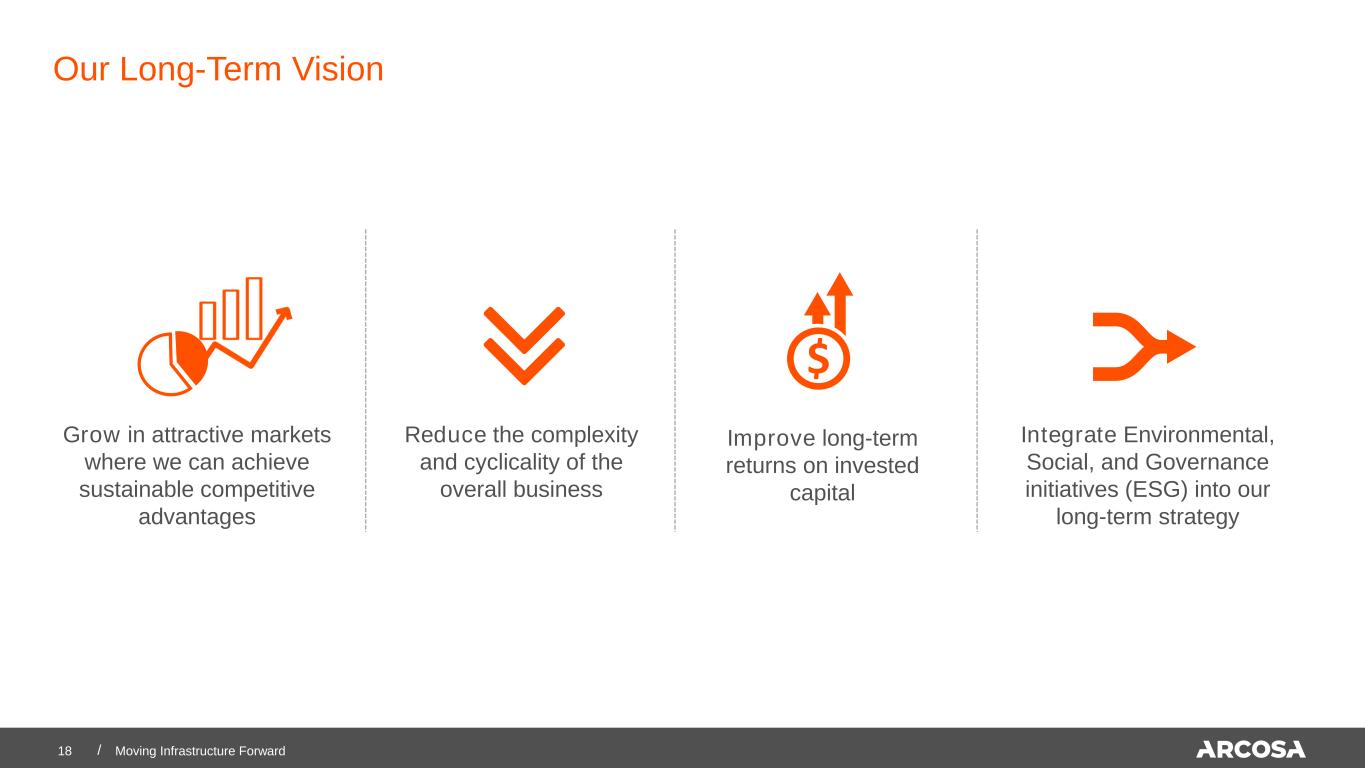
/18 Our Long-Term Vision Grow in attractive markets where we can achieve sustainable competitive advantages Reduce the complexity and cyclicality of the overall business Improve long-term returns on invested capital Integrate Environmental, Social, and Governance initiatives (ESG) into our long-term strategy Moving Infrastructure Forward

/19 Repositioning Arcosa Around More Stable Infrastructure Products Construction Products 2018 2020 Our 2020 performance highlights our progress in creating a more stable base of revenue and profit, anchored around core infrastructure products Moving Infrastructure Forward ▪ Natural aggregates operations, primarily in North Texas ▪ Lightweight aggregates ▪ Shoring products ▪ Natural aggregates operations in 7 states, including expanded footprint in Texas and Louisiana ▪ Recycled aggregates ▪ Lightweight aggregates ▪ Specialty materials for building products, agriculture, and other markets ▪ Shoring products 73 Engineered Structures ▪ Heavy reliance on Wind Towers product line ▪ Underperforming businesses in Utility Structures and Storage Tanks ▪ Significantly improved operations in Utility Structures and Storage Tanks, with segment EBITDA margins from 10% in 2018 to 13% in 2020 ▪ Reduced reliance on Wind Towers product line ▪ Added 3 adjacent infrastructure-related product lines of Traffic, Telecom, and Concrete structures ▪ Opportunities for additional organic growth in Transmission and Distribution structures Adjusted Segment EBITDA ($M’s) 116 Our Transportation segment generated $159M of cash flow from 2018- 2020 that funded growth in Construction and Engineered Structures1 Adjusted Segment EBITDA ($M’s) 1 Cash flow defined as EBITDA less CapEx. See 2020 10-K for CapEx by Segment 82 139
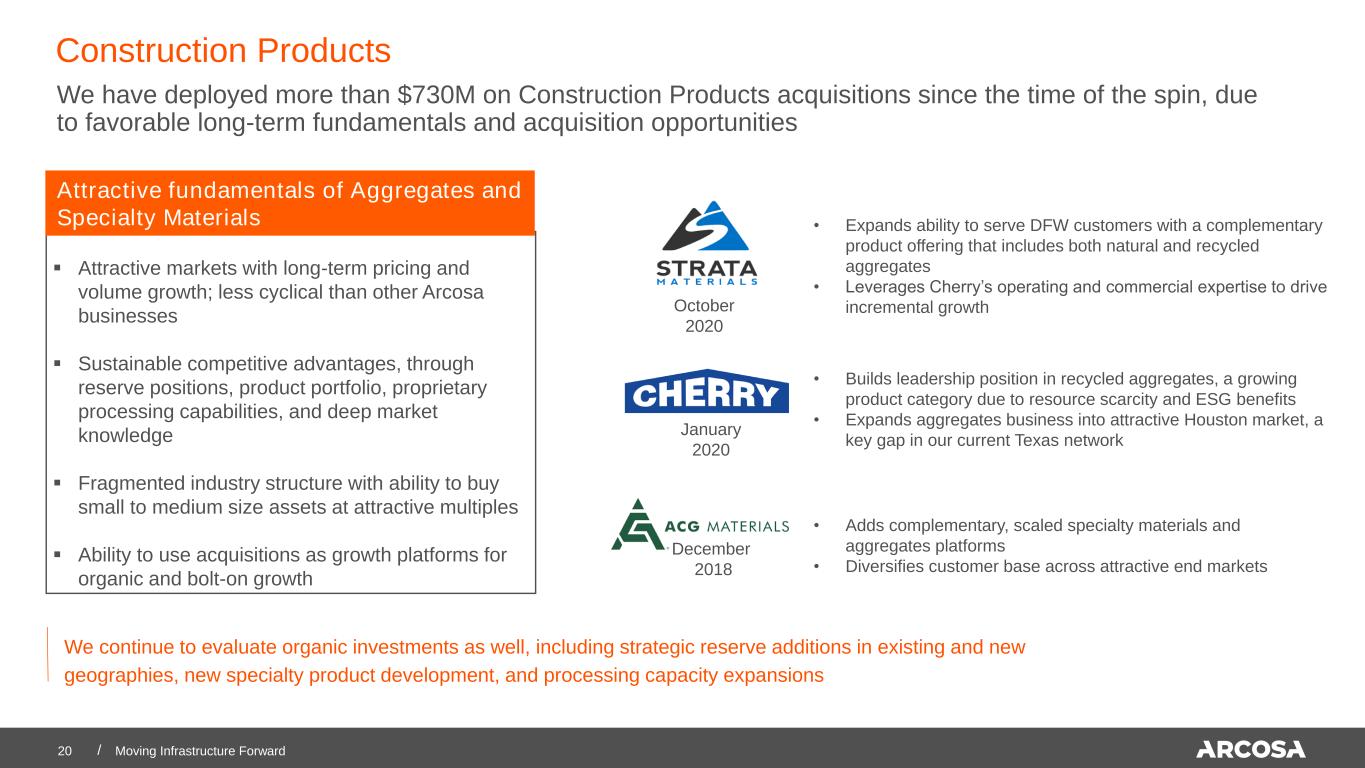
/ ▪ Attractive markets with long-term pricing and volume growth; less cyclical than other Arcosa businesses ▪ Sustainable competitive advantages, through reserve positions, product portfolio, proprietary processing capabilities, and deep market knowledge ▪ Fragmented industry structure with ability to buy small to medium size assets at attractive multiples ▪ Ability to use acquisitions as growth platforms for organic and bolt-on growth 20 We have deployed more than $730M on Construction Products acquisitions since the time of the spin, due to favorable long-term fundamentals and acquisition opportunities Attractive fundamentals of Aggregates and Specialty Materials Moving Infrastructure Forward Construction Products We continue to evaluate organic investments as well, including strategic reserve additions in existing and new geographies, new specialty product development, and processing capacity expansions October 2020 January 2020 December 2018 • Expands ability to serve DFW customers with a complementary product offering that includes both natural and recycled aggregates • Leverages Cherry’s operating and commercial expertise to drive incremental growth • Builds leadership position in recycled aggregates, a growing product category due to resource scarcity and ESG benefits • Expands aggregates business into attractive Houston market, a key gap in our current Texas network • Adds complementary, scaled specialty materials and aggregates platforms • Diversifies customer base across attractive end markets
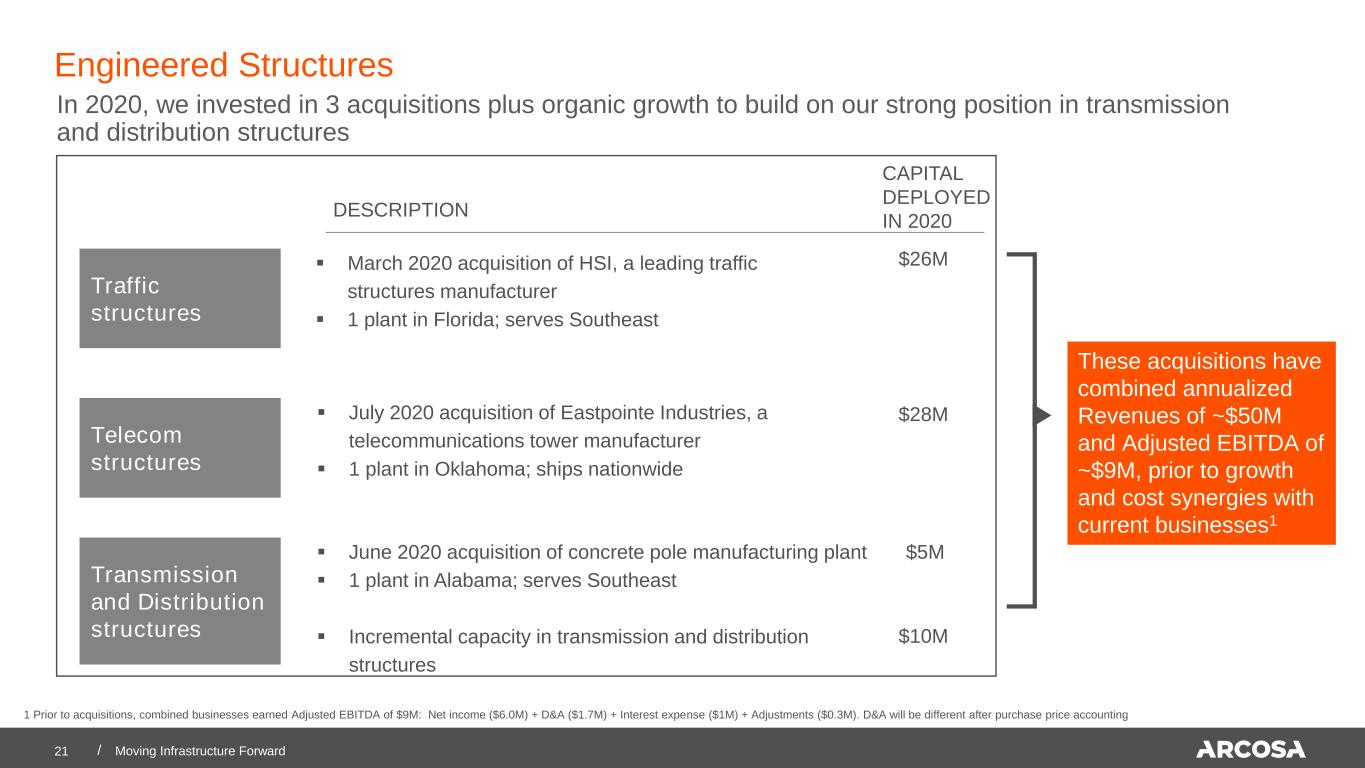
/21 Traffic structures ▪ March 2020 acquisition of HSI, a leading traffic structures manufacturer ▪ 1 plant in Florida; serves Southeast DESCRIPTION Telecom structures Transmission and Distribution structures CAPITAL DEPLOYED IN 2020 $26M ▪ July 2020 acquisition of Eastpointe Industries, a telecommunications tower manufacturer ▪ 1 plant in Oklahoma; ships nationwide $28M ▪ June 2020 acquisition of concrete pole manufacturing plant ▪ 1 plant in Alabama; serves Southeast ▪ Incremental capacity in transmission and distribution structures $5M Engineered Structures In 2020, we invested in 3 acquisitions plus organic growth to build on our strong position in transmission and distribution structures $10M These acquisitions have combined annualized Revenues of ~$50M and Adjusted EBITDA of ~$9M, prior to growth and cost synergies with current businesses1 Moving Infrastructure Forward 1 Prior to acquisitions, combined businesses earned Adjusted EBITDA of $9M: Net income ($6.0M) + D&A ($1.7M) + Interest expense ($1M) + Adjustments ($0.3M). D&A will be different after purchase price accounting

/22 Moving Infrastructure Forward Engineered Structures With our acquisitions, we have expanded our product offering in the $3B transmission and distribution markets, as well as entered new large markets tied to infrastructure growth Transmission & Distribution Structures Wind Towers Traffic Structures Telecom Structures Key Synergies ▪ Manufacturing expertise ▪ North American manufacturing footprint ▪ Steel sourcing ELECTRICITY TRANSMISSION & DISTRIBUTION ROAD INFRASTRUCTURE RENEWABLE POWER GENERATION COMMUNICATIONS INFRASTRUCTURE (INCLUDING 4G AND 5G BUILDOUT) END MARKETS AND PRODUCT LINES $500M+ $1.2B+ $3B+ $1.2B Source: Company and Third Party Estimates

/23 4 ESG Update Moving Infrastructure Forward
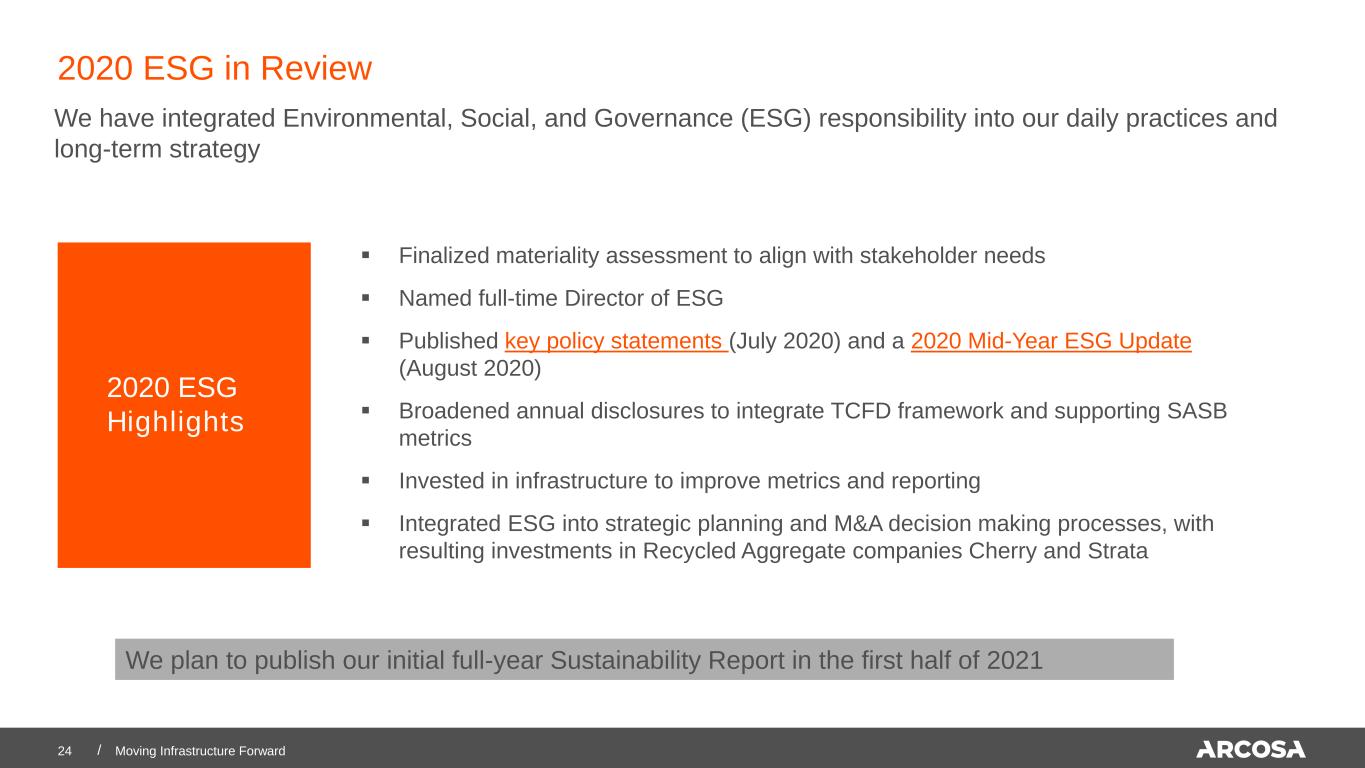
/ 2020 ESG in Review Moving Infrastructure Forward24 2020 ESG Highlights We plan to publish our initial full-year Sustainability Report in the first half of 2021 We have integrated Environmental, Social, and Governance (ESG) responsibility into our daily practices and long-term strategy ▪ Finalized materiality assessment to align with stakeholder needs ▪ Named full-time Director of ESG ▪ Published key policy statements (July 2020) and a 2020 Mid-Year ESG Update (August 2020) ▪ Broadened annual disclosures to integrate TCFD framework and supporting SASB metrics ▪ Invested in infrastructure to improve metrics and reporting ▪ Integrated ESG into strategic planning and M&A decision making processes, with resulting investments in Recycled Aggregate companies Cherry and Strata
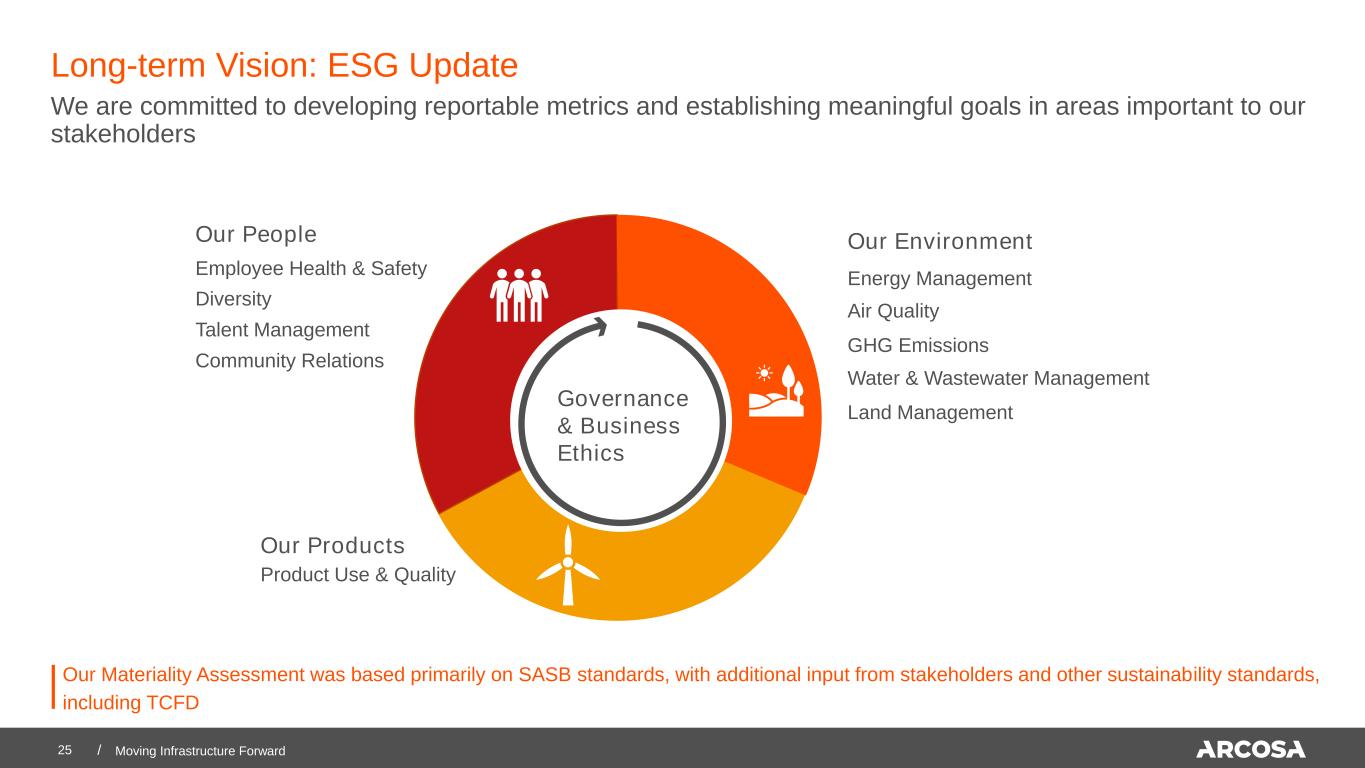
/25 We are committed to developing reportable metrics and establishing meaningful goals in areas important to our stakeholders Our Materiality Assessment was based primarily on SASB standards, with additional input from stakeholders and other sustainability standards, including TCFD Employee Health & Safety Diversity Talent Management Energy Management Air Quality GHG Emissions Product Use & Quality Water & Wastewater Management Land Management Community Relations Our Environment Our Products Our People Governance & Business Ethics Long-term Vision: ESG Update Moving Infrastructure Forward
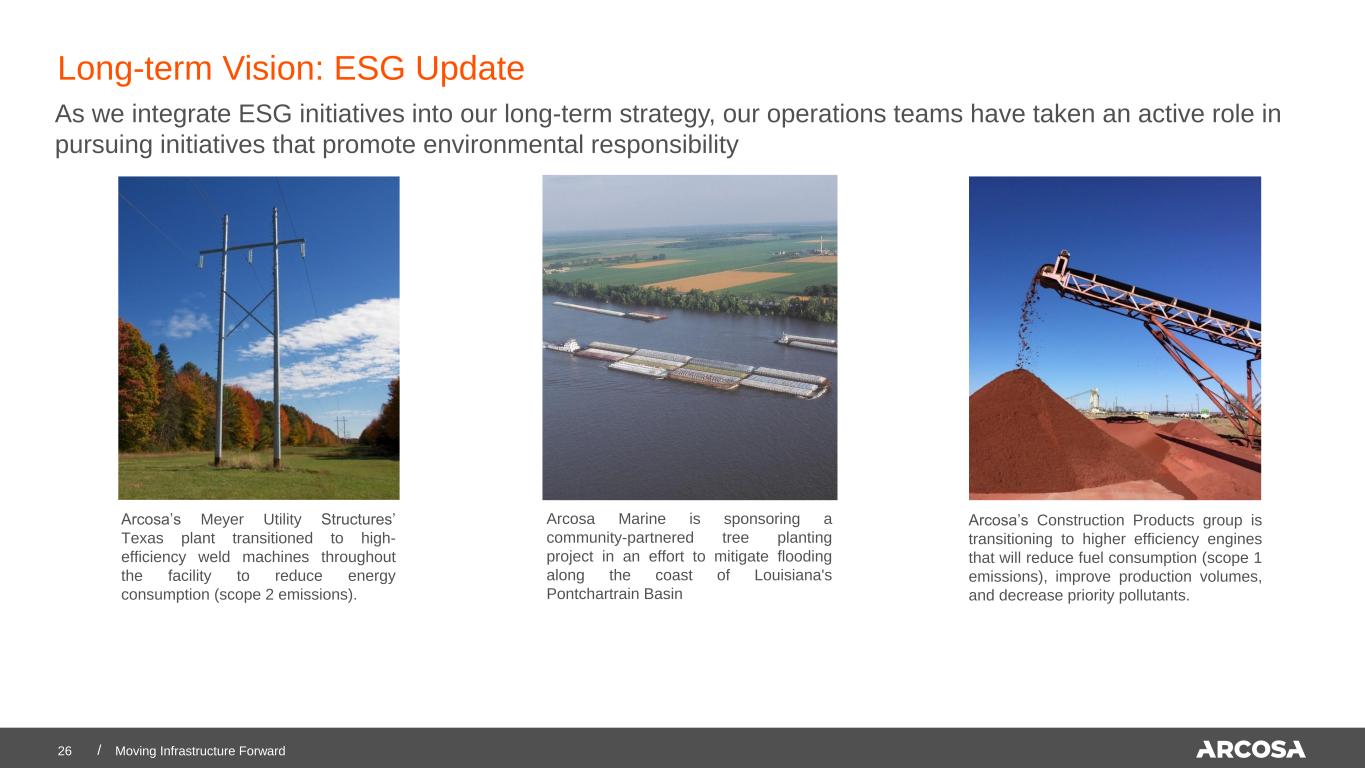
/ Long-term Vision: ESG Update Moving Infrastructure Forward26 As we integrate ESG initiatives into our long-term strategy, our operations teams have taken an active role in pursuing initiatives that promote environmental responsibility We provide more detail regarding our goals and initiatives in our August 2020 Midyear ESG Update located on our website, www.arcosa.com/sustainability, and expect further updates in our Full Year Sustainability Report in 2021 Arcosa’s Meyer Utility Structures’ Texas plant transitioned to high- efficiency weld machines throughout the facility to reduce energy consumption (scope 2 emissions). Arcosa Marine is sponsoring a community-partnered tree planting project in an effort to mitigate flooding along the coast of Louisiana's Pontchartrain Basin Arcosa’s Construction Products group is transitioning to higher efficiency engines that will reduce fuel consumption (scope 1 emissions), improve production volumes, and decrease priority pollutants.
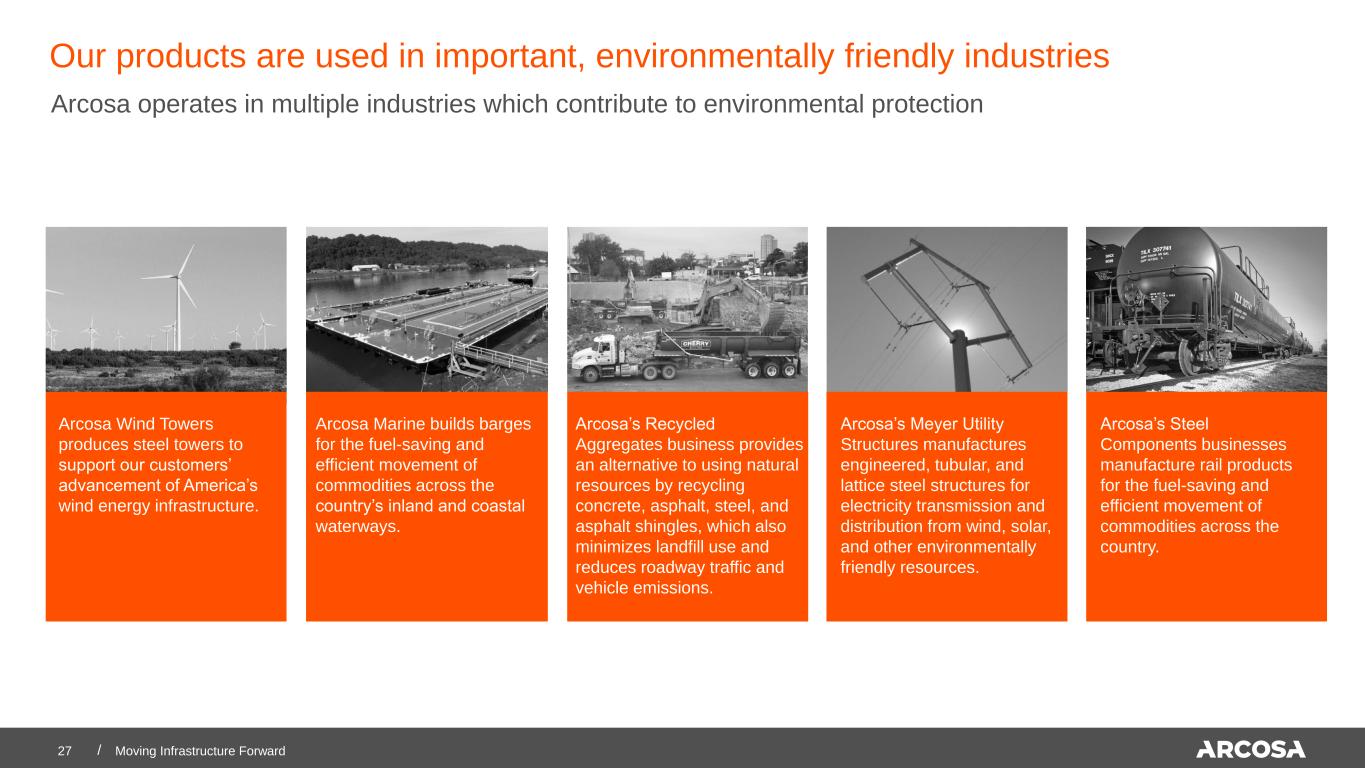
/27 Our products are used in important, environmentally friendly industries Arcosa operates in multiple industries which contribute to environmental protection Arcosa Wind Towers produces steel towers to support our customers’ advancement of America’s wind energy infrastructure. Arcosa Marine builds barges for the fuel-saving and efficient movement of commodities across the country’s inland and coastal waterways. Arcosa’s Recycled Aggregates business provides an alternative to using natural resources by recycling concrete, asphalt, steel, and asphalt shingles, which also minimizes landfill use and reduces roadway traffic and vehicle emissions. Arcosa’s Meyer Utility Structures manufactures engineered, tubular, and lattice steel structures for electricity transmission and distribution from wind, solar, and other environmentally friendly resources. Arcosa’s Steel Components businesses manufacture rail products for the fuel-saving and efficient movement of commodities across the country. Moving Infrastructure Forward
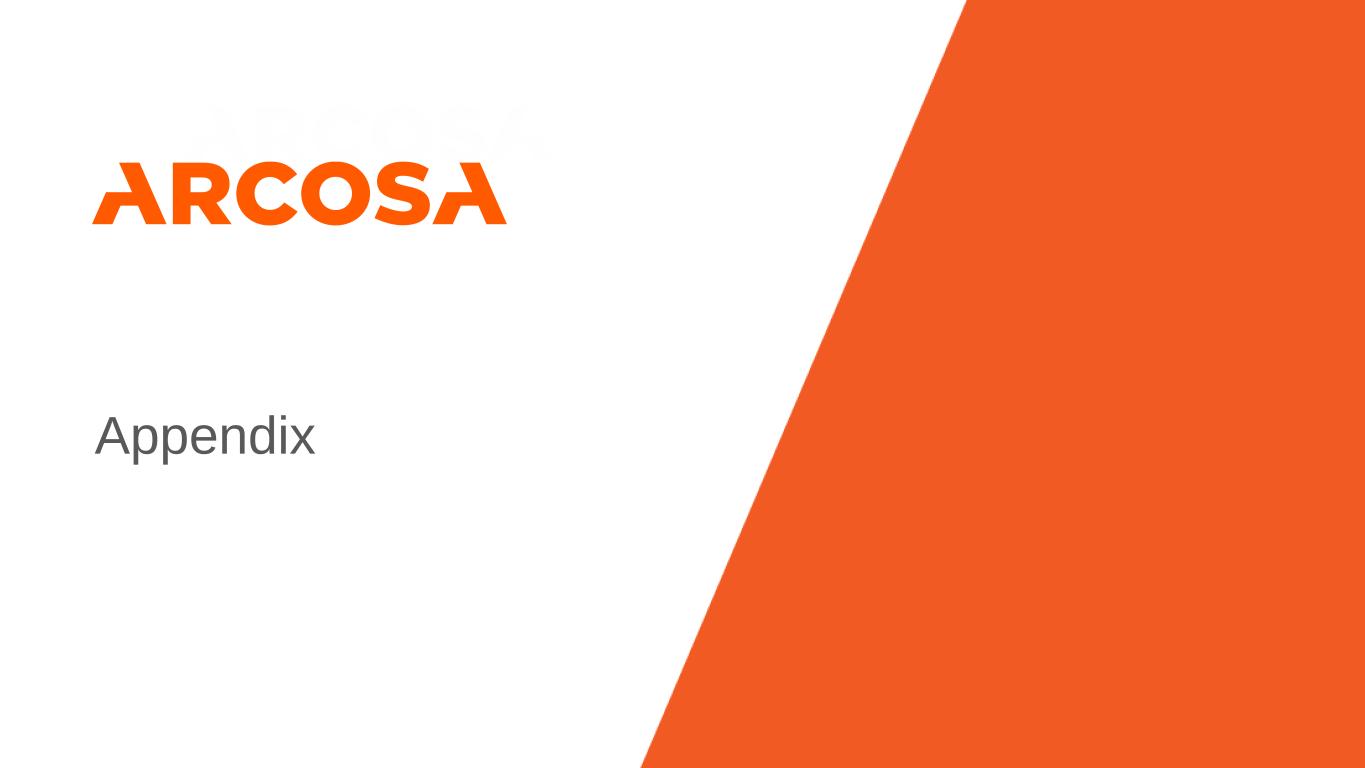
Appendix

/29 Additional Financial Guidance for 2021 Corporate costs Commentary Moving Infrastructure Forward Capital expenditures Working capital ▪ ~$13-14M per quarter, excluding potential one-time items related to acquisitions and integration ▪ $100-110M in 2021 (~$80M of maintenance capex + ~$20-$30M of growth projects) Tax rate ▪ Roughly flat working capital for the year, with potential for incremental improvements ▪ We expect a full year 2021 tax rate of ~23-25% February 2021 weather impact ▪ The February 2021 winter storm in Texas and the broader Southern United States will impact our Q1 performance, as we lost more than one week of production across a significant part of our operating footprint. ▪ As of the date of this presentation, we have restored operations in most of our facilities but may experience continuing impacts in our supply chain, particularly for steel mill production that was impacted by the storm
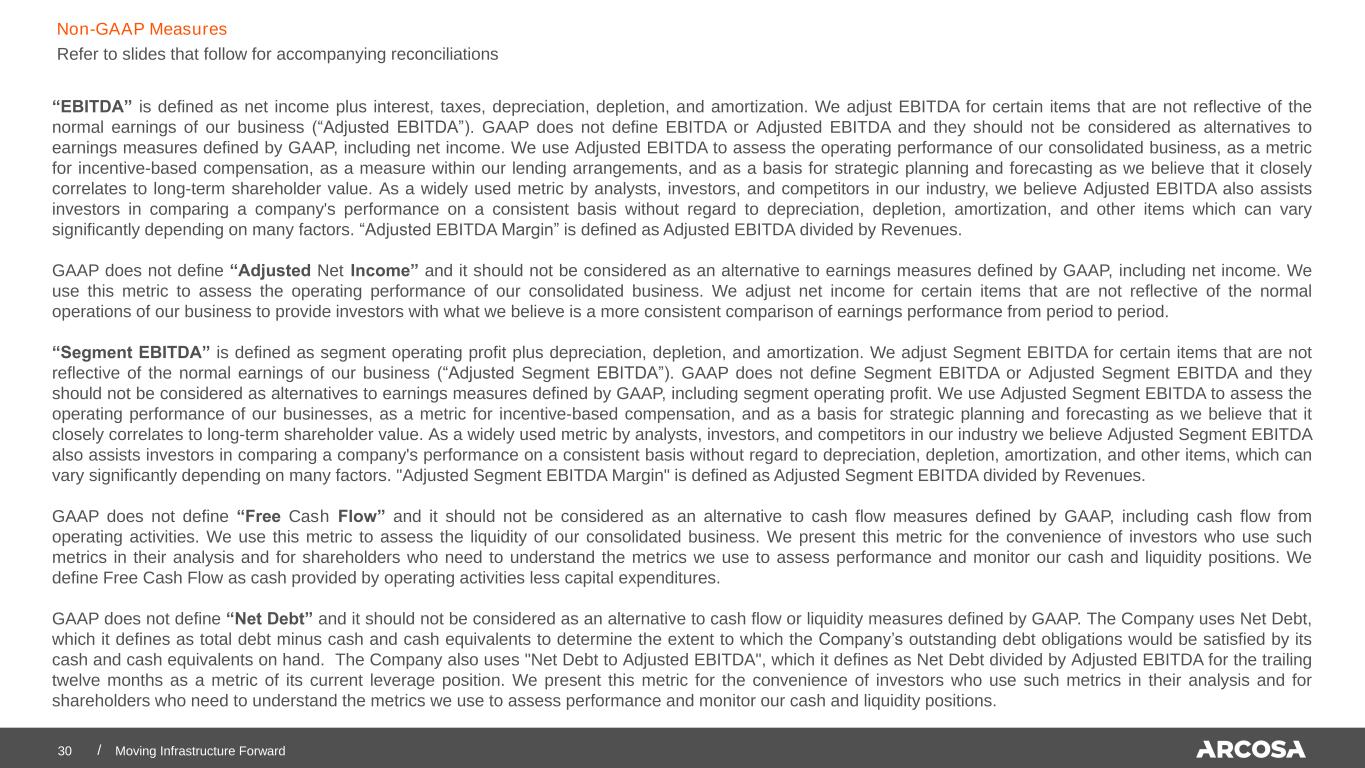
/ Non-GAAP Measures 30 Moving Infrastructure Forward “EBITDA” is defined as net income plus interest, taxes, depreciation, depletion, and amortization. We adjust EBITDA for certain items that are not reflective of the normal earnings of our business (“Adjusted EBITDA”). GAAP does not define EBITDA or Adjusted EBITDA and they should not be considered as alternatives to earnings measures defined by GAAP, including net income. We use Adjusted EBITDA to assess the operating performance of our consolidated business, as a metric for incentive-based compensation, as a measure within our lending arrangements, and as a basis for strategic planning and forecasting as we believe that it closely correlates to long-term shareholder value. As a widely used metric by analysts, investors, and competitors in our industry, we believe Adjusted EBITDA also assists investors in comparing a company's performance on a consistent basis without regard to depreciation, depletion, amortization, and other items which can vary significantly depending on many factors. “Adjusted EBITDA Margin” is defined as Adjusted EBITDA divided by Revenues. GAAP does not define “Adjusted Net Income” and it should not be considered as an alternative to earnings measures defined by GAAP, including net income. We use this metric to assess the operating performance of our consolidated business. We adjust net income for certain items that are not reflective of the normal operations of our business to provide investors with what we believe is a more consistent comparison of earnings performance from period to period. “Segment EBITDA” is defined as segment operating profit plus depreciation, depletion, and amortization. We adjust Segment EBITDA for certain items that are not reflective of the normal earnings of our business (“Adjusted Segment EBITDA”). GAAP does not define Segment EBITDA or Adjusted Segment EBITDA and they should not be considered as alternatives to earnings measures defined by GAAP, including segment operating profit. We use Adjusted Segment EBITDA to assess the operating performance of our businesses, as a metric for incentive-based compensation, and as a basis for strategic planning and forecasting as we believe that it closely correlates to long-term shareholder value. As a widely used metric by analysts, investors, and competitors in our industry we believe Adjusted Segment EBITDA also assists investors in comparing a company's performance on a consistent basis without regard to depreciation, depletion, amortization, and other items, which can vary significantly depending on many factors. "Adjusted Segment EBITDA Margin" is defined as Adjusted Segment EBITDA divided by Revenues. GAAP does not define “Free Cash Flow” and it should not be considered as an alternative to cash flow measures defined by GAAP, including cash flow from operating activities. We use this metric to assess the liquidity of our consolidated business. We present this metric for the convenience of investors who use such metrics in their analysis and for shareholders who need to understand the metrics we use to assess performance and monitor our cash and liquidity positions. We define Free Cash Flow as cash provided by operating activities less capital expenditures. GAAP does not define “Net Debt” and it should not be considered as an alternative to cash flow or liquidity measures defined by GAAP. The Company uses Net Debt, which it defines as total debt minus cash and cash equivalents to determine the extent to which the Company’s outstanding debt obligations would be satisfied by its cash and cash equivalents on hand. The Company also uses "Net Debt to Adjusted EBITDA", which it defines as Net Debt divided by Adjusted EBITDA for the trailing twelve months as a metric of its current leverage position. We present this metric for the convenience of investors who use such metrics in their analysis and for shareholders who need to understand the metrics we use to assess performance and monitor our cash and liquidity positions. Refer to slides that follow for accompanying reconciliations

/ Reconciliation of Adjusted EBITDA and Adjusted Net Income 31 Moving Infrastructure Forward (1) Includes the impact of the fair value markup of acquired long-lived assets. (2) Expenses associated with acquisitions, including the cost impact of the fair value markup of acquired inventory and other transaction costs. (3) Included in Other, net (income) expense was the impact of foreign currency exchange transactions of $3.6 million, $1.5 million, and $(0.2) million, $2.2 million, and $4.8 million for the years ended December 31, 2020, 2019, 2018, 2017 and 2016, respectively. ($’s in millions) (unaudited) 2016 2017 2018 2019 2020 Low High Net income $ 123.0 $ 89.7 $ 75.7 $ 113.3 $ 106.6 $ 88.0 $ 103.0 Add: Interest expense, net (0.1) (0.1) 0.5 5.4 10.2 10.0 10.0 Provision for income taxes 74.2 40.4 19.3 33.5 31.6 28.0 33.0 Depreciation, depletion, and amortization expense (1) 65.6 65.7 67.6 85.8 114.5 124.0 124.0 EBITDA 262.7 195.7 163.1 238.0 262.9 250.0 270.0 Add: Impact of acquisition-related expenses (2) - - 0.8 2.0 10.3 - - Impairment charge - - 23.2 - 7.1 - - Other, net (income) expense (3) 3.7 1.7 (0.6) 0.7 3.4 - - Adjusted EBITDA 266.4$ 197.4$ 186.5$ 240.7$ 283.7$ 250.0$ 270.0$ Adjusted EBITDA Margin 15.6% 13.5% 12.8% 13.9% 14.7% 14.0% 14.2% Full Year 2021 Guidance Year Ended December 31,
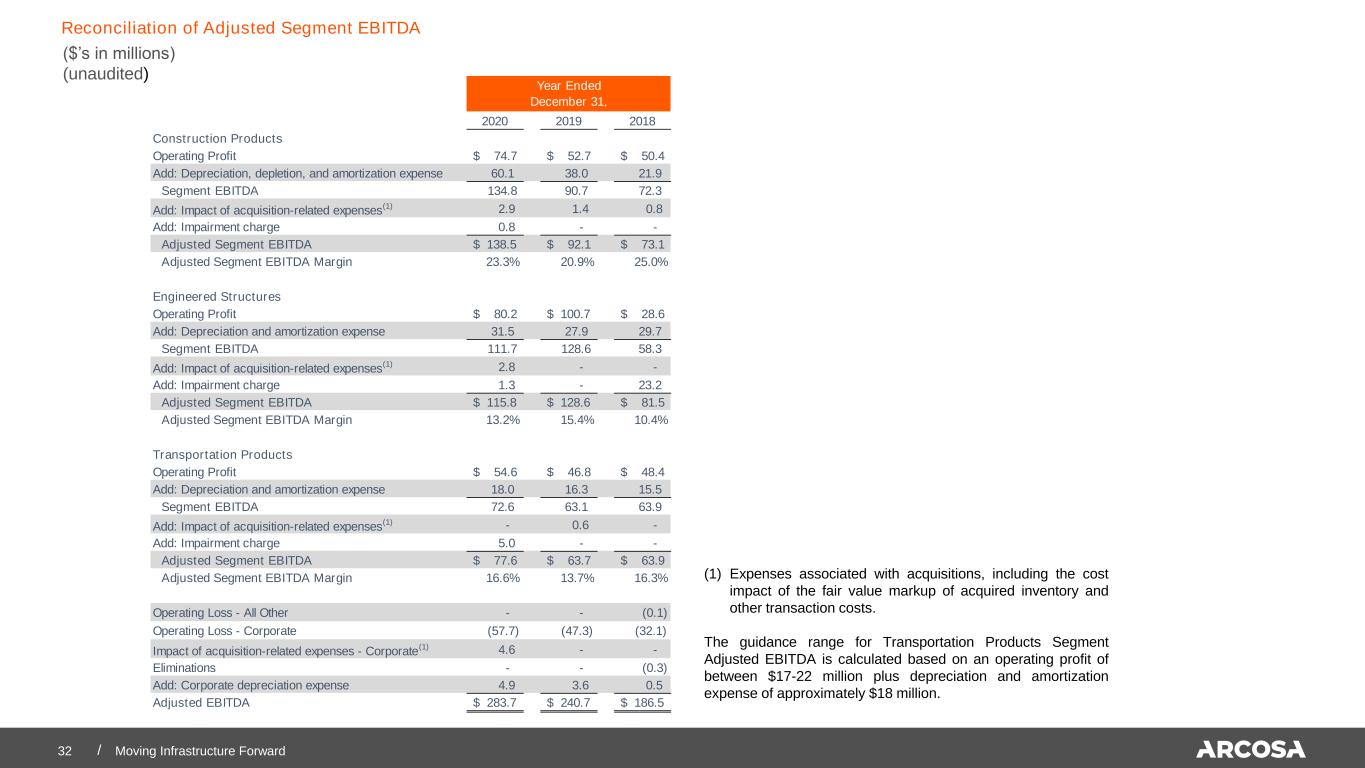
/ Reconciliation of Adjusted Segment EBITDA 32 Moving Infrastructure Forward ($’s in millions) (unaudited) (1) Expenses associated with acquisitions, including the cost impact of the fair value markup of acquired inventory and other transaction costs. The guidance range for Transportation Products Segment Adjusted EBITDA is calculated based on an operating profit of between $17-22 million plus depreciation and amortization expense of approximately $18 million. 2020 2019 2018 Construction Products Operating Profit $ 74.7 $ 52.7 $ 50.4 Add: Depreciation, depletion, and amortization expense 60.1 38.0 21.9 Segment EBITDA 134.8 90.7 72.3 Add: Impact of acquisition-related expenses (1) 2.9 1.4 0.8 Add: Impairment charge 0.8 - - Adjusted Segment EBITDA $ 138.5 $ 92.1 $ 73.1 Adjusted Segment EBITDA Margin 23.3% 20.9% 25.0% Engineered Structures Operating Profit $ 80.2 $ 100.7 $ 28.6 Add: Depreciation and amortization expense 31.5 27.9 29.7 Segment EBITDA 111.7 128.6 58.3 Add: Impact of acquisition-related expenses (1) 2.8 - - Add: Impairment charge 1.3 - 23.2 Adjusted Segment EBITDA $ 115.8 $ 128.6 $ 81.5 Adjusted Segment EBITDA Margin 13.2% 15.4% 10.4% Transportation Products Operating Profit $ 54.6 $ 46.8 $ 48.4 Add: Depreciation and amortization expense 18.0 16.3 15.5 Segment EBITDA 72.6 63.1 63.9 Add: Impact of acquisition-related expenses (1) - 0.6 - Add: Impairment charge 5.0 - - Adjusted Segment EBITDA $ 77.6 $ 63.7 $ 63.9 Adjusted Segment EBITDA Margin 16.6% 13.7% 16.3% Operating Loss - All Other - - (0.1) Operating Loss - Corporate (57.7) (47.3) (32.1) Impact of acquisition-related expenses - Corporate (1) 4.6 - - Eliminations - - (0.3) Add: Corporate depreciation expense 4.9 3.6 0.5 Adjusted EBITDA $ 283.7 $ 240.7 $ 186.5 Year Ended December 31,
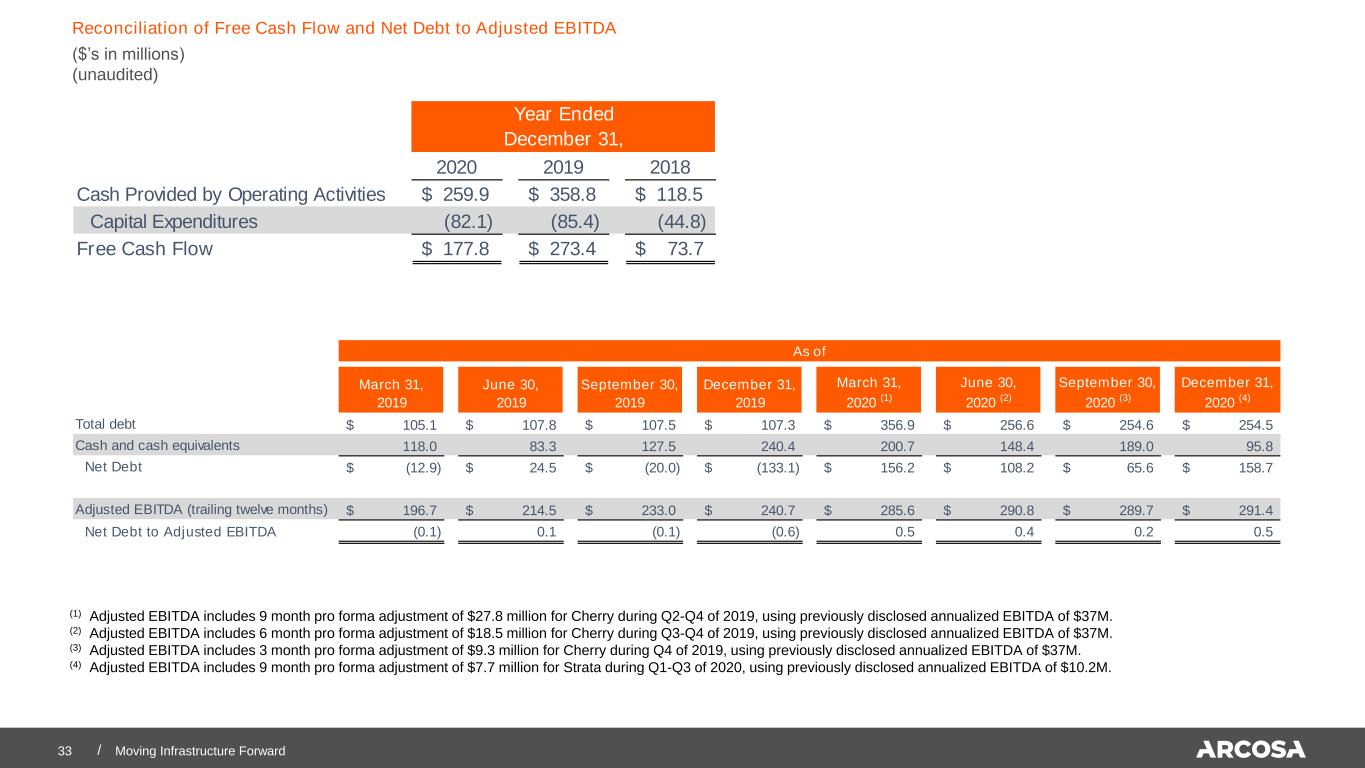
/ Reconciliation of Free Cash Flow and Net Debt to Adjusted EBITDA 33 Moving Infrastructure Forward ($’s in millions) (unaudited) (1) Adjusted EBITDA includes 9 month pro forma adjustment of $27.8 million for Cherry during Q2-Q4 of 2019, using previously disclosed annualized EBITDA of $37M. (2) Adjusted EBITDA includes 6 month pro forma adjustment of $18.5 million for Cherry during Q3-Q4 of 2019, using previously disclosed annualized EBITDA of $37M. (3) Adjusted EBITDA includes 3 month pro forma adjustment of $9.3 million for Cherry during Q4 of 2019, using previously disclosed annualized EBITDA of $37M. (4) Adjusted EBITDA includes 9 month pro forma adjustment of $7.7 million for Strata during Q1-Q3 of 2020, using previously disclosed annualized EBITDA of $10.2M. March 31, 2019 June 30, 2019 September 30, 2019 December 31, 2019 March 31, 2020 (1) June 30, 2020 (2) September 30, 2020 (3) December 31, 2020 (4) Total debt 105.1$ 107.8$ 107.5$ 107.3$ 356.9$ 256.6$ 254.6$ 254.5$ Cash and cash equivalents 118.0 83.3 127.5 240.4 200.7 148.4 189.0 95.8 Net Debt (12.9)$ 24.5$ (20.0)$ (133.1)$ 156.2$ 108.2$ 65.6$ 158.7$ Adjusted EBITDA (trailing twelve months) 196.7$ 214.5$ 233.0$ 240.7$ 285.6$ 290.8$ 289.7$ 291.4$ Net Debt to Adjusted EBITDA (0.1) 0.1 (0.1) (0.6) 0.5 0.4 0.2 0.5 As of 2020 2019 2018 Cash Provided by Operating Activities $ 259.9 $ 358.8 $ 118.5 Capital Expenditures (82.1) (85.4) (44.8) Free Cash Flow $ 177.8 $ 273.4 $ 73.7 Year Ended December 31,

/34 Moving Infrastructure Forward Strata Materials Adjusted EBITDA ($’s in millions) (unaudited) Reconciliation of Strata Materials EBITDA Twelve Months Ended August 31, 2020 Net income $ 5.9 Add: Interest expense, net 0.4 Provision for income taxes - Depreciation, depletion, and amortization expense 2.8 Pro-Forma adjustments, primarily for start-up plant 1.1 EBITDA $ 10.2
